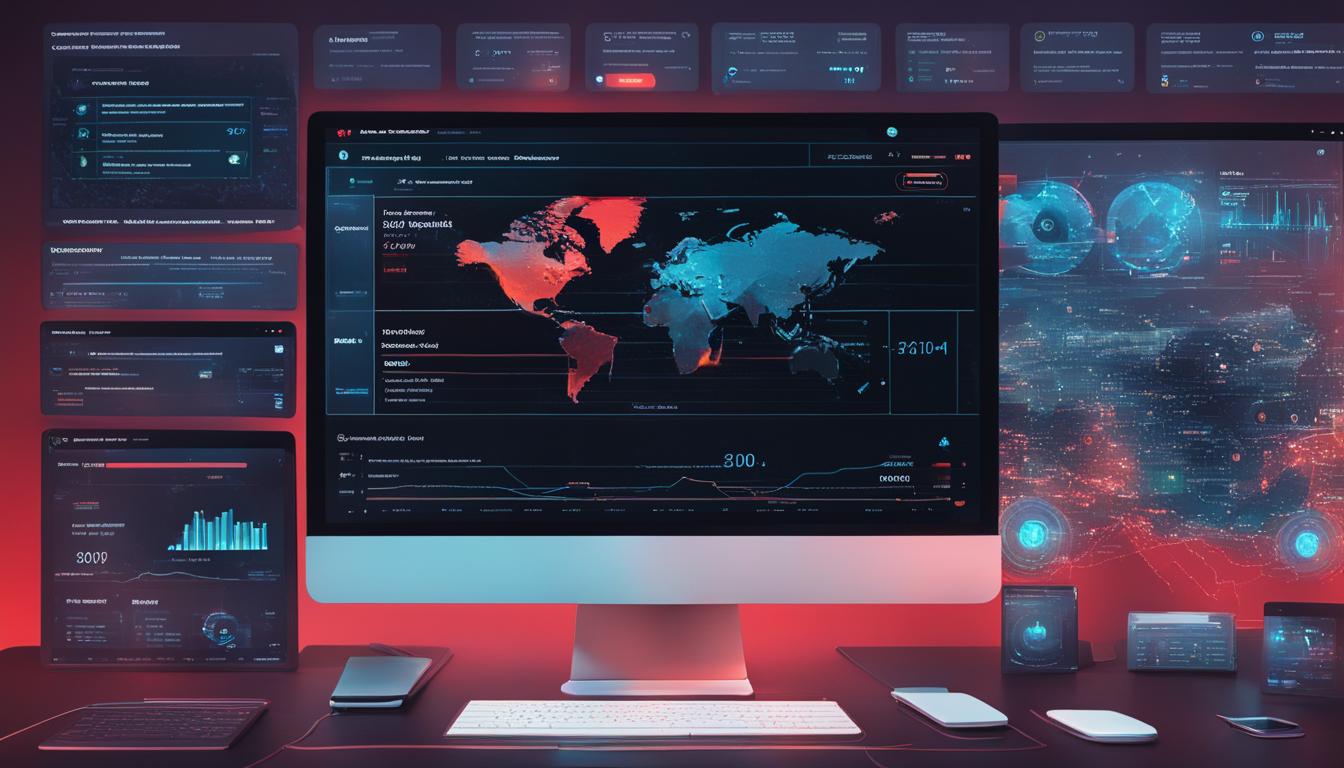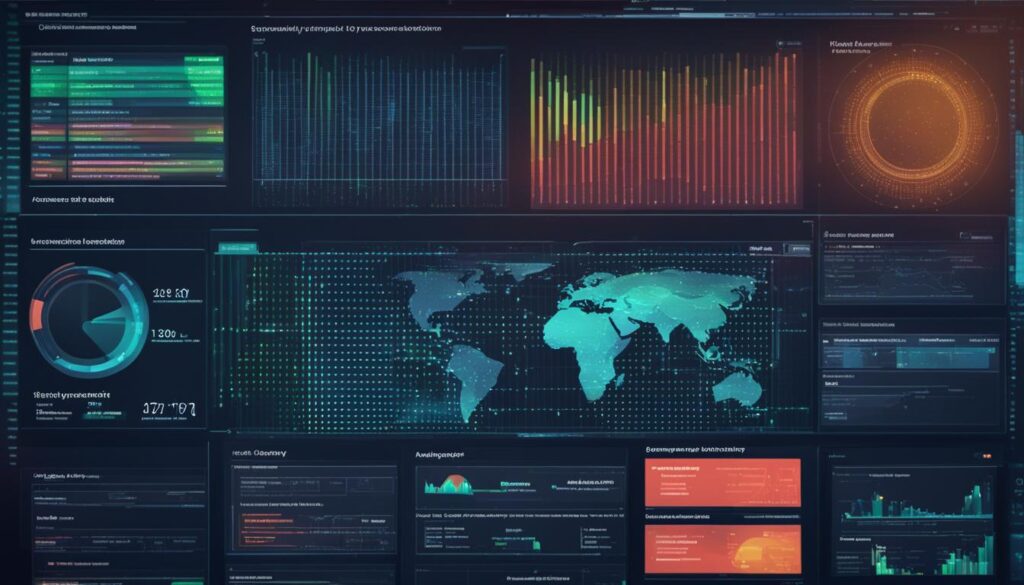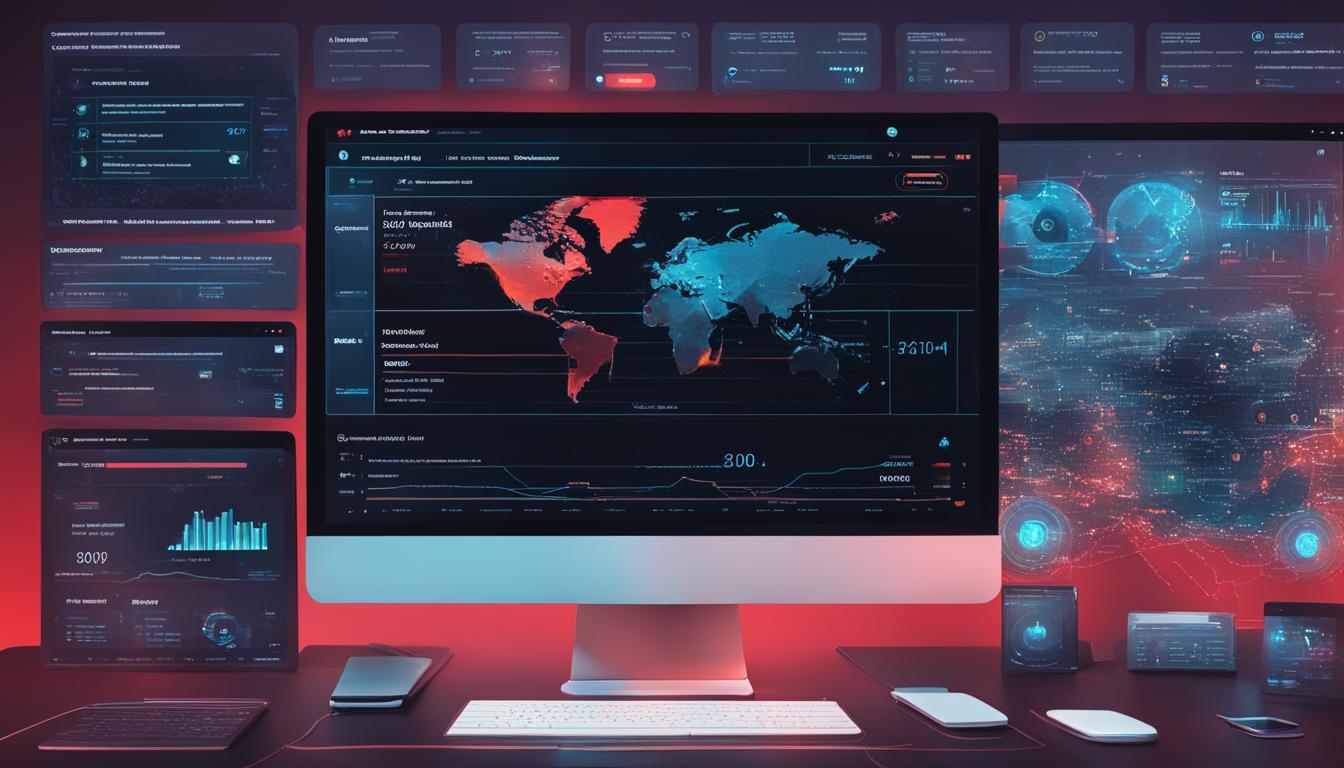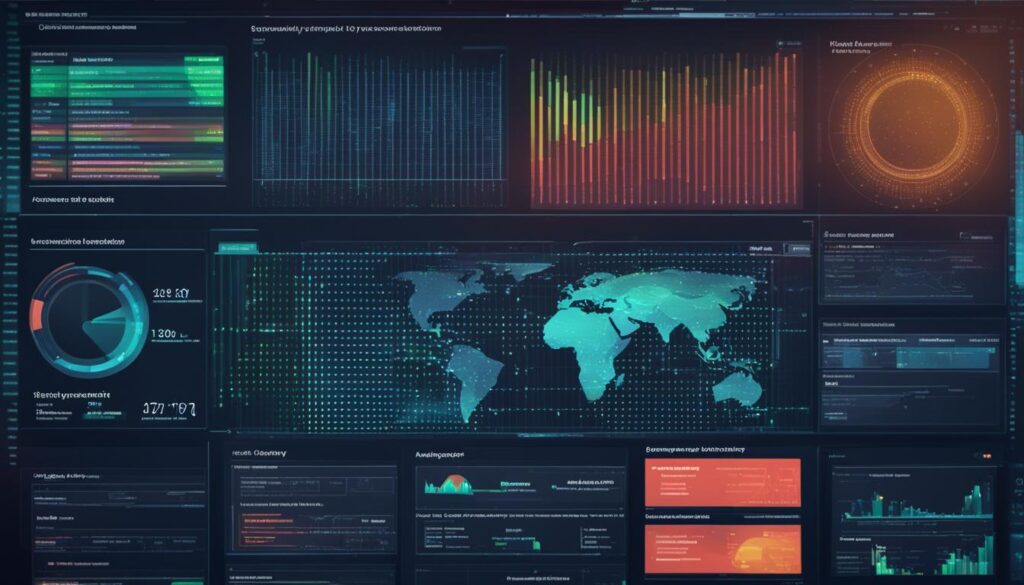AI Security
Unlock the Power of Robust AI Security for Your Business

Artificial intelligence (AI) is revolutionizing the way businesses operate, offering opportunities for growth and innovation. As AI increasingly integrates into various aspects of daily life, it’s crucial to focus on AI cybersecurity to protect your business from cyber threats and to ensure the robustness of your AI systems.
Developing a strong AI security strategy is essential to leverage the full potential of AI and safeguard your business from potential threats. This involves understanding the unique security challenges that AI presents, implementing effective controls and compliance measures, and continuously refining your AI security strategy.
In this article, we will explore the intricacies of AI cybersecurity and provide valuable insights into how you can protect your AI systems from hacking. By adopting robust AI security measures, you can confidently harness the power of AI while ensuring the privacy, integrity, and availability of your data.
Key Takeaways:
- Developing a robust AI security strategy is essential for protecting your business from hacking.
- Understand the unique security challenges that AI presents and implement effective controls and compliance measures.
- Continuously refine your AI security strategy to stay ahead of emerging threats.
- Make data privacy, integrity, and availability a top priority in your AI security approach.
- Adopt robust AI security measures that align with industry best practices and regulatory requirements.
Understanding the Opportunity of AI
AI has the potential to revolutionize businesses by offering personalized customer experiences and transforming the way companies operate. By leveraging AI, businesses can unlock new opportunities for growth and innovation. Through AI-powered technologies, companies can enhance customer interactions, automate processes, and optimize marketing campaigns.
Personalized customer experiences are a key driver of business success, and AI enables companies to tailor their offerings to individual preferences. By analyzing vast amounts of data, AI algorithms can identify patterns and trends, allowing businesses to deliver personalized recommendations, offers, and solutions. This level of customization not only improves customer satisfaction but also increases customer loyalty and drives revenue growth.
Additionally, AI can streamline business operations by automating repetitive tasks and optimizing processes. By delegating routine tasks to AI-powered systems, employees can focus on higher-value activities that require human expertise, creativity, and decision-making. This not only increases productivity but also improves overall operational efficiency.
“AI presents businesses with the opportunity to enhance operations, improve customer experiences, and gain a competitive edge.”
Developing a robust AI strategy is essential for businesses to fully capitalize on the opportunity that AI presents. By aligning AI initiatives with business goals and investing in the right technologies and talent, companies can revolutionize their operations and unlock new levels of success.
| Benefits of AI for Businesses | Examples |
|---|---|
| Enhanced customer experiences | Personalized product recommendations, chatbots for customer support |
| Operational efficiency | Automated data entry, predictive maintenance |
| Optimized marketing campaigns | Targeted advertising, dynamic pricing |
Overcoming the Challenges of AI Implementation
Implementing artificial intelligence (AI) in your business can be a daunting task, but it doesn’t have to be. By understanding and addressing the challenges of AI implementation, you can set your organization up for success. Proper integration and starting small are key strategies that can help overcome these challenges.
One common misconception about AI implementation is that it requires building complex technology from scratch. However, this is not the case. By adopting open-source AI tools and incorporating data from third-party providers, you can leverage existing resources and capabilities. Starting small allows you to experiment and learn from small-scale AI projects, gradually refining your approach over time.
Key Challenges of AI Implementation
- Lack of understanding about AI technology and its potential applications
- Resistance to change and fear of job displacement
- Insufficient data quality and availability
- Integration complexities with existing systems and processes
- Compatibility issues with legacy hardware and software
- Privacy and security concerns
By identifying and addressing these challenges, you can navigate the implementation process more effectively. It’s important to involve key stakeholders and provide sufficient training and support to ensure a smooth transition. Remember, AI implementation is not a one-size-fits-all approach; it requires careful planning and adaptation to your organization’s specific needs and goals.
| Challenge | Solution |
|---|---|
| Lack of understanding about AI technology and its potential applications | Educate key stakeholders through workshops and training sessions to build awareness and knowledge. |
| Resistance to change and fear of job displacement | Communicate the benefits of AI implementation, emphasizing how it can enhance job roles and create new opportunities. |
| Insufficient data quality and availability | Invest in data management and quality improvement initiatives, ensuring data is accurate, relevant, and readily accessible. |
| Integration complexities with existing systems and processes | Collaborate closely with IT and operations teams to develop a seamless integration plan, addressing potential bottlenecks. |
| Compatibility issues with legacy hardware and software | Evaluate and upgrade infrastructure as needed to ensure compatibility and optimal performance. |
| Privacy and security concerns | Implement robust security measures and comply with data protection regulations to safeguard sensitive information. |
By taking a proactive approach and addressing these challenges head-on, you can successfully implement AI in your business. Remember to start small and gradually scale your initiatives, leveraging existing resources and capabilities. With proper integration and a clear understanding of the potential benefits, AI can revolutionize your business and drive growth and innovation.
Assembling an AI Governance Board
Developing an effective AI strategy requires assembling an AI governance board to provide strategic direction, diverse perspectives, and ensure the successful implementation of AI initiatives. This board plays a crucial role in setting the ethical framework, goals, and funding for the organization’s AI program.
The AI governance board should consist of top management and representatives from various departments, such as IT, legal, and operations. This ensures that decision-making authority is distributed and diverse perspectives are incorporated. By having a range of viewpoints, the board can make informed decisions that align with the organization’s values and objectives.
Furthermore, the AI governance board is responsible for driving and monitoring AI implementation across the organization. They ensure that the AI strategy remains on track, aligns with business goals, and adapts to evolving technologies and regulations. Regular reporting and communication with stakeholders help maintain transparency and accountability throughout the AI journey.
Overall, assembling an AI governance board is a critical step in developing a robust AI strategy. By bringing together a diverse group of experts and stakeholders, organizations can ensure that their AI initiatives are aligned with strategic direction, ethical considerations, and ultimately, drive success in the fast-paced world of artificial intelligence.
AI Governance Board: Key Responsibilities
- Setting the strategic direction and goals for the organization’s AI initiatives.
- Establishing the ethical framework and guidelines for responsible AI deployment.
- Overseeing the funding and resource allocation for AI projects.
- Ensuring compliance with legal and regulatory requirements related to AI.
- Monitoring and evaluating the performance and impact of AI initiatives.
- Providing guidance and support to the organization in navigating the AI landscape.
Benefits of a Diverse AI Governance Board
“A diverse AI governance board brings together different perspectives, experiences, and expertise, allowing for more comprehensive and informed decision-making. It helps avoid bias, promotes innovation, and ensures that AI initiatives address the needs and values of all stakeholders.” – AI Expert
By considering a wide range of perspectives, organizations can make more informed decisions and avoid potential pitfalls or blind spots that may arise from a lack of diverse viewpoints. This not only enhances the effectiveness of AI strategy but also helps build trust with employees, customers, and other stakeholders.
| Benefits of a Diverse AI Governance Board | Examples |
|---|---|
| Promotes innovation and creativity | Encourages new ideas and approaches that may not have been considered otherwise. |
| Avoids bias and discrimination | Reduces the risk of AI systems perpetuating bias and ensures fair and inclusive decision-making. |
| Considers diverse stakeholder needs | Takes into account the perspectives and interests of employees, customers, and the wider community. |
| Enhances decision-making | Brings together a range of expertise and experiences to make informed and well-rounded decisions. |
Defining AI Objectives, Use Cases, and Ethical Principles
When implementing artificial intelligence (AI) in our business, it is essential to have clear objectives and use cases that align with our strategic goals. By defining specific areas where AI can create value, we can focus our efforts effectively. For example, we might aim to improve efficiency by automating repetitive tasks or enhance customer experiences by personalizing interactions.
An important aspect of AI integration is considering ethical principles from the outset. Ethical AI deployment ensures that our technology aligns with societal values and respects individual privacy. By establishing ethical guidelines, we demonstrate our commitment to responsible AI and build trust with our customers and stakeholders.
Defining AI Objectives
To define AI objectives, it is crucial to involve key stakeholders from various departments. This collaborative approach ensures that our objectives are aligned with the overall business strategy. We can identify areas where AI can have the most significant impact and set measurable goals for success. Regular monitoring and evaluation help us stay on track and make adjustments as needed.
Identifying AI Use Cases
Once we have defined our objectives, it is time to identify specific use cases where AI can be applied. This involves analyzing our current processes and identifying areas that could benefit from AI automation or optimization. By focusing on use cases that align with our objectives, we can prioritize our AI initiatives and allocate resources effectively.
Establishing Ethical Principles
As AI technology continues to evolve, it is essential to address ethical considerations. By establishing ethical principles, we ensure that our AI systems adhere to legal and moral standards. This includes respecting privacy, avoiding bias in decision-making algorithms, and being transparent about the use of AI. Regular reviews and audits help us maintain ethical standards and adapt to any emerging challenges.
| AI Objectives | Use Cases | Ethical Principles |
|---|---|---|
| Improve efficiency | Automate repetitive tasks | Respect privacy and data security |
| Enhance customer experiences | Personalize interactions | Avoid bias in decision-making algorithms |
| Optimize marketing campaigns | Identify target audiences | Be transparent about the use of AI |
Performing an AI Risk Assessment
When implementing AI technology in your business, it is crucial to conduct a comprehensive AI risk assessment. This assessment helps identify potential risks and allows for proactive measures to be taken to mitigate them. By identifying risks early on, you can ensure responsible AI deployment and prevent any negative impacts on your business.
During the AI risk assessment, it is important to evaluate various factors that can pose risks to your AI systems. This includes assessing data privacy and security, as well as considering liability and reputational risks. By thoroughly examining these areas, you can implement the necessary controls and safeguards to protect your AI systems and the data they handle.
To effectively identify potential risks, it is recommended to seek professional assistance. AI experts can provide valuable guidance in navigating the complex legal and ethical considerations surrounding AI implementation. They can help you analyze the specific risks that may be relevant to your business and develop tailored strategies to address them.
Benefits of Proactive AI Risk Assessment
An AI risk assessment is not only about mitigating potential risks, but also about ensuring the long-term success of your AI initiatives. By taking a proactive approach to risk assessment, you can:
- Identify potential vulnerabilities and weaknesses in your AI systems
- Implement appropriate controls and compliance measures
- Protect sensitive data and maintain customer trust
- Ensure compliance with relevant regulations and industry standards
- Enhance the overall security and reliability of your AI infrastructure
| Risk Category | Potential Risks | Proactive Measures |
|---|---|---|
| Data Privacy | Potential breaches of customer data, unauthorized access | Implement robust encryption, access controls, and data anonymization techniques |
| Security | Malicious attacks, hacking attempts | Implement advanced cybersecurity measures, conduct regular vulnerability assessments, and apply patches and updates |
| Liability | Potential legal implications arising from AI decisions or actions | Establish clear accountability and responsibility frameworks, ensure transparency in AI decision-making processes |
| Reputational | Potential damage to the company’s reputation due to AI failures or misuse | Implement rigorous quality assurance processes, monitor AI performance, and address any issues promptly |
Through proactive AI risk assessment and the implementation of appropriate measures, you can ensure that your AI systems operate securely, ethically, and effectively. By addressing potential risks early on, you can harness the full potential of AI while maintaining the trust of your stakeholders and protecting your business interests.
Implementing Controls and Compliance Measures
In order to ensure the security and protection of AI systems, it is crucial to implement controls and compliance measures. These measures play a vital role in safeguarding AI intellectual property, mitigating risks, and ensuring responsible AI deployment.
Inventory of AI Systems
One of the first steps in implementing controls is maintaining an inventory of AI systems. This allows for better visibility and understanding of the various AI technologies and applications within an organization. By documenting the different AI systems in use, companies can more effectively manage and monitor their AI initiatives.
Documenting AI Decisions
Documenting AI decisions that require human oversight is another important control measure. This ensures transparency and accountability in the decision-making process. By keeping a record of AI decisions, companies can evaluate the impact and effectiveness of AI systems, as well as address any potential biases or ethical concerns that may arise.
AI Monitoring Tools
Utilizing AI monitoring tools is essential for staying proactive and identifying any issues or anomalies in AI systems. These tools help monitor the performance and behavior of AI algorithms, allowing for early detection of any potential risks or vulnerabilities. By continuously monitoring AI systems, companies can take swift action to address any issues and maintain the integrity and security of their AI deployments.
Protecting AI Intellectual Property
Protecting AI intellectual property is a critical aspect of implementing controls and compliance measures. This involves utilizing patents, trade secret measures, and well-worded contracting terms to safeguard the innovative AI technologies and algorithms developed by the organization. By securing AI intellectual property, companies can maintain a competitive advantage and prevent unauthorized use or replication of their AI assets.
Implementing controls and compliance measures is essential for protecting AI intellectual property and ensuring responsible AI deployment. By maintaining an inventory of AI systems, documenting AI decisions, utilizing AI monitoring tools, and protecting AI intellectual property, companies can proactively manage the risks associated with AI and establish a strong foundation for secure and ethical AI implementation.
Managing and Maintaining Data for AI Success
Effective management and maintenance of data are critical for the success of AI initiatives. By ensuring data accuracy, protecting against data breaches, and complying with data protection regulations, businesses can maximize the potential of AI while safeguarding customer trust and privacy.
Data accuracy is essential to the optimal performance of AI systems. Regularly reviewing and maintaining data integrity helps to minimize errors and ensures reliable insights and predictions. Implementing data validation processes and conducting regular audits are key to maintaining data accuracy.
Compliance with data protection regulations, such as the General Data Protection Regulation (GDPR), is crucial for businesses to maintain the trust and confidence of their customers. Adhering to regulations ensures that personal data is collected, stored, and processed securely and responsibly. Companies need to adopt robust data protection measures, including encryption, access controls, and data anonymization to safeguard sensitive information.

Table: Summary of Data Protection Regulations
| Regulation | Description |
|---|---|
| GDPR | European Union regulation that protects the personal data and privacy of EU citizens. |
| CCPA | California Consumer Privacy Act that regulates the collection and use of personal information by businesses operating in California. |
| PIPA | Personal Information Protection Act in South Korea that governs the collection, use, and disclosure of personal information. |
| PDPA | Personal Data Protection Act in Singapore that establishes a data protection legal framework. |
Implementing robust data management practices is essential for AI success. This includes proper data capture, transformation, and enrichment processes to ensure data is relevant and reliable. Regular data quality assessments and data cleansing activities enable businesses to maintain a high level of data accuracy and integrity.
By managing and maintaining data effectively, businesses can unlock the full potential of AI and drive growth, efficiency, and innovation while upholding customer trust and complying with data protection regulations.
Monitoring, Updating, and Refining Your AI Strategy
Once your AI strategy is implemented, it’s crucial to continuously monitor its performance, update it regularly, and stay informed about the latest developments in the field of AI. By doing so, you can ensure that your AI initiatives remain effective, aligned with your business goals, and capable of delivering maximum value.
Monitoring the performance of your AI strategy allows you to track its impact on key performance indicators (KPIs) and identify any areas for improvement. By analyzing data and measuring outcomes, you can gain valuable insights into the effectiveness of your AI applications and make informed decisions about refining or expanding them.
Updating your AI strategy is essential because the AI landscape is rapidly evolving. New technologies, algorithms, and best practices emerge regularly, and staying up-to-date with these developments is crucial to maintaining a competitive advantage. By keeping a pulse on the latest AI trends, you can identify opportunities for innovation, assess potential risks, and make informed decisions about incorporating new techniques or tools into your AI strategy.
Staying informed about AI developments involves actively engaging with the AI community, attending conferences and webinars, reading industry publications, and participating in online forums. By doing so, you can stay ahead of the curve, gain insights from industry experts, and learn from the experiences of others. This continuous learning and knowledge sharing will help you refine your AI strategy, optimize your implementation processes, and drive greater business value.
Key Strategies for Monitoring, Updating, and Refining Your AI Strategy:
- Regularly track and analyze key performance indicators (KPIs) to assess the impact of your AI applications.
- Stay up-to-date with the latest AI technologies, algorithms, and best practices through industry publications and conferences.
- Engage with the AI community to gain insights from industry experts and learn from their experiences.
- Continuously evaluate and update your AI strategy to incorporate new techniques and tools that can enhance its effectiveness.
- Monitor market trends and customer feedback to identify potential areas for innovation and improvement.
Summary
Monitoring, updating, and refining your AI strategy is a critical aspect of leveraging the full potential of AI in your business. By regularly assessing the performance of your AI applications, staying informed about the latest AI developments, and actively engaging with the AI community, you can ensure that your AI strategy remains effective, adaptable, and aligned with your business goals. This ongoing process of optimization and improvement will enable you to stay ahead of the competition, drive innovation, and maximize the value of your AI investments.
The Power of AI Integration
Welcome to our latest article on harnessing the power of artificial intelligence (AI) integration for your business. As AI continues to shape industries and drive innovation, integrating AI tools and data sources into your business strategy is crucial for unlocking its full potential. By leveraging existing AI tools, embracing modular tech architectures, and utilizing diverse data sources, you can harness the transformative power of AI to drive growth, efficiency, and success.
Key Takeaways:
- Integrating AI tools and data sources enhances business operations and decision-making.
- Modular tech architectures allow for scalability and flexibility in AI implementation.
- Utilizing diverse data sources enriches AI capabilities and insights.
- Starting small and gradually scaling AI initiatives ensures successful integration.
- Continuous monitoring and updating of AI strategy drive long-term success.
Conclusion: Unlocking the Potential of Robust AI Security
In today’s digital landscape, robust AI security is essential to protect businesses from hacking and cyber threats. Developing a comprehensive AI strategy empowers organizations to harness the power of AI and drive growth, efficiency, and innovation. By assembling an AI governance board, defining clear objectives and ethical principles, performing a risk assessment, implementing controls and compliance measures, managing data effectively, and continually refining the strategy, businesses can unlock the full potential of AI. With the right approach, AI can be a strategic tool that enhances cybersecurity and safeguards sensitive data.
AI-powered solutions play a pivotal role in fortifying cybersecurity defenses. Machine learning, a subset of AI, revolutionizes threat detection and protection by analyzing patterns, identifying vulnerabilities, and automating responses. AI strengthens endpoint security, improves post-breach recovery, ensures business continuity, and helps businesses meet regulatory compliance. The power of AI in cybersecurity not only protects against data breaches and unauthorized access but also elevates the public reputation of businesses, fostering trust and driving growth.
The future of AI in cybersecurity is promising, with continued evolution and refinement of AI algorithms. AI will become smarter and faster in identifying and combating threats, creating adaptive security measures. Privacy and ethics will remain paramount, guiding responsible and ethical AI development. As AI systems evolve, they will provide unparalleled security protection, ensuring the safety and resilience of businesses in an ever-changing digital landscape.
| Benefits of Robust AI Security | Protect AI from Hacking |
|---|---|
| Enhances cybersecurity defenses | Identifies vulnerabilities |
| Strengthens endpoint security | Protects against data breaches |
| Improves post-breach recovery | Prevents unauthorized access |
| Ensures business continuity | Safeguards data and networks |
| Helps meet regulatory compliance | Boosts public reputation |
The Transformative Power of Machine Learning in Cybersecurity
Machine learning plays a crucial role in bolstering cybersecurity defenses, leveraging its capabilities to fortify organizations against evolving threats. By automating vulnerability scanning, machine learning algorithms predict and identify potential weak points, enhancing proactive defense measures. This enables organizations to stay one step ahead of hackers and reduce the risk of successful cyber attacks.
One area where machine learning excels is in malware detection. By analyzing patterns from previous attacks, machine learning algorithms can identify new and emerging threats, even those that have not been seen before. This capability allows organizations to detect and respond to malware attacks in real-time, minimizing damage and protecting sensitive data.
Machine learning is also instrumental in analyzing user behavior to identify potential threats. By establishing patterns of normal behavior, machine learning algorithms can quickly recognize abnormal activity that may indicate an unauthorized intrusion or suspicious activity. This proactive approach enhances threat detection and response, enabling organizations to mitigate potential threats before they can cause significant damage.
Furthermore, machine learning assists in fraud detection by analyzing transaction patterns and identifying inconsistencies that may indicate fraudulent activity. By utilizing machine learning algorithms, organizations can detect and prevent financial fraud, protecting both their assets and the interests of their customers.
The transformative power of machine learning in cybersecurity cannot be overstated. It enables organizations to enhance their defenses, detect and respond to threats more effectively, and protect sensitive data from malicious actors. As the field of machine learning continues to evolve, so too will its impact on cybersecurity, paving the way for even more advanced and robust security solutions.

Table: Machine Learning Applications in Cybersecurity
| Application | Description |
|---|---|
| Vulnerability Scanning | Automated identification of weak points and potential vulnerabilities in systems and networks. |
| Malware Detection | Analyzing patterns from previous attacks to identify new and emerging malware threats. |
| User Behavior Analysis | Establishing patterns of normal behavior to identify abnormal activity that may indicate unauthorized access. |
| Fraud Detection | Analyzing transaction patterns to identify inconsistencies and detect potential fraudulent activity. |
AI’s Role in Cybersecurity
In today’s digital landscape, cybersecurity has become a top priority for businesses and individuals alike. As threats become more sophisticated and complex, traditional security measures may no longer be sufficient. This is where artificial intelligence (AI) plays a crucial role. With its ability to analyze vast amounts of data and identify patterns, AI has emerged as a powerful tool in cybersecurity.
Intelligent systems powered by AI can detect and respond to cyber threats in real-time, enabling proactive defenses. These systems leverage advanced machine learning algorithms to continuously learn and adapt to new threats, making them highly effective in combating evolving cyber attacks. By automatically analyzing network traffic, monitoring user behavior, and detecting anomalies, AI-powered solutions can identify potential threats before they even manifest, allowing organizations to take timely action to prevent breaches.
AI’s ability to analyze vast amounts of data in real-time enables proactive defenses and early threat detection, helping organizations stay one step ahead of cyber criminals.
Moreover, AI can assist in automating the analysis of security logs and alerts, reducing the burden on cybersecurity teams and enabling them to focus on more complex tasks. This improves response times and enhances overall incident management. AI can also play a crucial role in incident response, aiding investigators by correlating data from multiple sources and providing valuable insights to identify the root cause of an attack and mitigate its impact.
As cyber threats continue to evolve, it is essential for organizations to adopt proactive cybersecurity measures. AI offers an intelligent and scalable approach to defend against these threats. By harnessing the power of AI, businesses can strengthen their cybersecurity posture, safeguard their sensitive data, and protect their reputation in the digital landscape.
Table: Benefits of AI in Cybersecurity
| Benefit | Description |
|---|---|
| Proactive Threat Detection | AI-powered systems can detect and respond to cyber threats in real-time, identifying and mitigating risks before they cause significant damage. |
| Automated Analysis | AI can automate the analysis of security logs and alerts, reducing the workload on cybersecurity teams and improving incident response times. |
| Anomaly Detection | Using advanced machine learning algorithms, AI can identify abnormal patterns and behaviors, enabling early detection of potential attacks. |
| Enhanced Incident Response | AI assists in incident response by correlating data from various sources, providing valuable insights to investigators, and aiding in the mitigation of cyber threats. |
| Scalability | AI-powered cybersecurity solutions can handle large volumes of data and scale to meet the evolving needs of organizations. |
The Power of AI in Cybersecurity
When it comes to protecting against data breaches and preventing unauthorized user access, AI is a powerful tool in the field of cybersecurity. By leveraging AI technologies, businesses can fortify their defenses, enhance endpoint security, and ensure business continuity. With AI-powered solutions, companies can stay one step ahead of cyber threats and meet regulatory compliance.
AI plays a pivotal role in identifying vulnerabilities and protecting against data breaches. Through its intelligent systems, AI can detect and analyze patterns, identifying potential threats in real-time. By continuously monitoring network activity and analyzing data, AI can proactively identify and neutralize threats before they can cause significant damage.
Another key advantage of using AI in cybersecurity is its ability to prevent unauthorized user access. With AI-powered authentication systems, businesses can implement multi-factor authentication and biometrics, adding an extra layer of security to protect sensitive data. AI can automatically detect suspicious behavior and flag potential threats, helping to prevent unauthorized access to critical systems.
Furthermore, AI can safeguard data and networks by enhancing post-breach recovery processes. Through automated incident response systems, AI can quickly identify and isolate affected systems, minimizing the impact of a breach and enabling a faster recovery. AI can also assist in forensic analysis, helping businesses understand the extent of the breach and gather evidence for legal proceedings.
In conclusion, the power of AI in cybersecurity cannot be overlooked. By leveraging AI technologies, businesses can protect against data breaches, prevent unauthorized user access, and ensure the security and integrity of their systems. As cyber threats continue to evolve, incorporating AI into cybersecurity strategies becomes increasingly vital to stay ahead of malicious actors and safeguard valuable assets.
The Future of AI-Powered Solutions in Cybersecurity
As we look ahead, the future of AI in cybersecurity is filled with exciting possibilities. AI technology is constantly evolving, and we can expect AI algorithms to become even smarter, faster, and more sophisticated in identifying and combating cyber threats. The power of machine learning will play a crucial role in creating adaptive security measures that can proactively defend against emerging risks.
While AI continues to revolutionize cybersecurity, privacy and ethics remain at the forefront. Responsible and ethical AI development is essential to ensure that AI-powered solutions uphold privacy rights and adhere to ethical standards. As AI evolves, it is our responsibility to ensure that it is used in ways that respect user privacy and foster trust in the digital landscape.
Looking ahead, we envision more robust, reliable, and adaptable AI systems that provide unparalleled security protection. These systems will help businesses stay one step ahead of cyber threats, safeguarding sensitive data and networks. By embracing the future of AI in cybersecurity, we can create a safer digital environment for all.
FAQ
What is the importance of developing a robust AI strategy?
Developing a robust AI strategy is crucial to leverage the full potential of AI and drive growth, efficiency, and innovation in businesses.
How can AI enhance operations and improve customer experiences?
AI enables companies to personalize customer experiences, automate processes, and optimize marketing campaigns, leading to improved operations and customer satisfaction.
What are the challenges of implementing AI?
Many companies hesitate to embark on AI projects due to misconceptions about complexity. However, proper integration, process change, and starting small can help overcome implementation challenges.
What is the role of an AI governance board?
An AI governance board sets the strategic direction, ethical framework, goals, and funding for the AI program, ensuring decision-making authority and diverse perspectives.
How should companies define objectives and use cases for AI?
Clear objectives and use cases that align with business priorities should be identified to ensure AI initiatives create value and are ethically deployed.
Why is performing an AI risk assessment important?
Conducting a comprehensive risk assessment helps identify potential risks such as data privacy, security, liability, and reputational risks, allowing proactive measures to be taken.
What controls and compliance measures should be implemented for AI?
Controls and compliance measures include maintaining an inventory of AI systems, documenting AI decisions, utilizing AI monitoring tools, and considering appropriate insurance coverage.
How should companies manage and maintain data for AI success?
Regularly reviewing and maintaining data accuracy and relevance, complying with data protection regulations, and implementing sound data management practices are essential for optimal AI performance.
How should companies monitor, update, and refine their AI strategy?
Regularly assessing AI performance, refining processes, incorporating new learnings and data, and staying informed about AI developments ensure the AI strategy remains relevant and impactful.
How can companies integrate AI into their business strategy?
Integration involves leveraging existing AI tools and data sources, starting small, experimenting, and gradually scaling AI capabilities using open-source AI tools and modular tech architectures.
How does machine learning fortify cybersecurity defenses?
Machine learning aids in vulnerability scanning, malware detection, threat detection and protection, and fraud detection by analyzing patterns and behavior for improved cybersecurity.
What role does AI play in cybersecurity?
AI provides intelligent systems that mimic human thinking, identify threats, and automate responses, making cybersecurity defenses more resilient and effective over time.
How does AI strengthen cybersecurity?
AI strengthens cybersecurity by identifying vulnerabilities, protecting against data breaches and cyber attacks, preventing unauthorized access, and ensuring data and network security.
What does the future hold for AI in cybersecurity?
The future involves the evolution and refinement of AI algorithms, creating smarter and faster systems with adaptive security measures and a focus on responsible and ethical AI development.
Bennett is the embodiment of versatility, adapting his writing to cover a broad spectrum of topics with professionalism and flair. Whether it’s breaking news, in-depth analyses, or feature pieces, Bennett’s contributions enrich Press Report with diverse perspectives and engaging content. His adaptability and keen journalistic instincts make him a vital member of our team, capable of capturing the essence of the moment in every story.
AI Security
Unlock the Benefits of AI-Powered Cybersecurity Today

Join us as we delve into the benefits of AI-powered cybersecurity. In today’s digital age, enterprises face increasingly sophisticated cyber threats that can compromise sensitive data and disrupt operations. To combat these evolving challenges, AI has emerged as a critical element in cybersecurity, offering a range of advantages for detecting threats, managing incident responses, and improving security protocols overall.
In this article, we will explore how AI is revolutionizing the field of cybersecurity and the advantages it brings to organizations. From enhanced threat detection to automated incident response, AI-driven cybersecurity solutions are transforming the way we protect our digital assets.
Key Takeaways:
- AI-powered cybersecurity offers numerous benefits for organizations.
- AI can detect and respond to threats faster, automate processes, improve accuracy and efficiency, and provide scalability and cost savings.
- Implementing AI in cybersecurity can enhance incident response, identify potential threats more effectively, and proactively protect digital assets.
- Challenges of implementing AI in cybersecurity include data quality, adversarial attacks, and ethical considerations.
- The future of AI in cybersecurity holds great potential for protecting against evolving cyber threats.
Now, let’s delve into the role of AI in cybersecurity and discover how it is transforming the way we defend against cyberattacks.
The Role of AI in Cybersecurity
AI algorithms are revolutionizing the field of cybersecurity, enhancing organizations’ ability to protect against evolving threats. By employing AI in cybersecurity, we can detect anomalies and potential risks in real time, strengthening our overall defense mechanisms. AI algorithms have the power to process and interpret vast amounts of data from various sources, enabling us to identify patterns and behaviors indicative of cyberattacks.
One of the key advantages of AI in cybersecurity is the improvement in threat detection accuracy. AI-powered systems can analyze network traffic, user behavior, and system logs to identify suspicious activities that might go unnoticed by traditional methods. This allows us to proactively respond to potential threats before they cause significant damage. Additionally, AI can automate certain security tasks, such as analyzing log files and identifying vulnerabilities, which saves time and resources for organizations.
Another important aspect of AI in cybersecurity is its role in automated incident response. AI algorithms can swiftly analyze and assess the severity of security incidents, enabling us to take immediate action. This automated response capability helps to minimize the impact of cyberattacks and reduces overall response times. By leveraging AI in incident response, organizations can effectively mitigate threats and protect their digital assets.
Enhanced Cybersecurity with AI Algorithms
AI algorithms play a crucial role in enhancing cybersecurity defenses. They enable us to analyze vast amounts of data, detect anomalies, and automate incident response, thereby improving our overall security posture. With the ever-increasing complexity and sophistication of cyber threats, AI is becoming an indispensable tool in the fight against cybercrime.
| Benefits of AI in Cybersecurity | Examples |
|---|---|
| Enhanced threat detection | Real-time analysis of network traffic for potential threats |
| Automated incident response | Immediate action taken based on AI assessment of severity |
| Improved accuracy and efficiency | AI algorithms can process and interpret large volumes of data with precision |
| Cost savings | Automation of certain security tasks reduces the need for manual intervention |
By leveraging AI algorithms in cybersecurity, we can stay one step ahead of cybercriminals and protect our digital assets effectively. With the continuous advancements in AI technology, we anticipate even greater capabilities in the future, enabling us to combat emerging threats with more accuracy and efficiency.

AI algorithms enable us to process and interpret vast amounts of data, identify patterns, and detect potential cyber threats in real time. By automating certain security tasks and enhancing incident response capabilities, we can bolster our cybersecurity defenses and protect our digital assets.
Overall, the role of AI in cybersecurity is pivotal. Its ability to analyze data, detect anomalies, and automate processes provides organizations with a significant advantage in the fight against cyber threats. By embracing AI-powered cybersecurity solutions, we can enhance our overall security posture and ensure the integrity of our systems and data.
AI-Powered Solutions for Cybersecurity
In today’s rapidly evolving digital landscape, organizations are turning to AI-powered solutions to bolster their cybersecurity defenses. AI technology offers a range of benefits, enabling organizations to detect and respond to threats more effectively, automate processes, and enhance overall security. By harnessing the power of AI, organizations can stay one step ahead of cybercriminals and protect their valuable digital assets.
One significant application of AI in cybersecurity is through Security Information and Event Management (SIEM) systems. These systems leverage AI algorithms to analyze security incidents in real time, allowing organizations to identify patterns and anomalies indicative of cyber threats. By proactively monitoring and analyzing security events, organizations can swiftly detect and respond to potential breaches, minimizing the impact on their systems and data.
Another key AI-powered solution in cybersecurity is threat intelligence platforms. These platforms aggregate and analyze data from various sources, providing organizations with essential insights into emerging threats. By leveraging AI algorithms to process vast amounts of data, organizations gain a comprehensive understanding of the threat landscape, enabling them to implement proactive measures to mitigate potential risks.
| AI-Powered Solutions for Cybersecurity | Benefits |
|---|---|
| Security Information and Event Management (SIEM) systems | Analyze security incidents in real time, identify patterns and anomalies indicative of cyber threats, proactive threat monitoring and response |
| Threat intelligence platforms | Aggregate and analyze data from various sources, identify emerging threats, proactive risk mitigation |
| Automated remediation systems | Initiate predefined actions to mitigate cybersecurity incidents, reduce response times and minimize the impact of attacks |
In addition to SIEM and threat intelligence, automated remediation systems powered by AI are invaluable in cybersecurity. These systems can automatically initiate predefined actions to mitigate cybersecurity incidents, significantly reducing response times and minimizing the impact of attacks. By leveraging AI-driven automation, organizations can swiftly and efficiently respond to threats, ensuring the integrity and security of their systems.
Overall, AI-powered solutions are revolutionizing the cybersecurity industry by providing organizations with enhanced capabilities to protect against cyber threats. Whether it’s through the real-time analysis of security incidents, comprehensive threat intelligence, or automated incident response, AI technology is proving to be a valuable asset in strengthening organizations’ cybersecurity defense strategies.
The Challenges of Implementing AI in Cybersecurity
Implementing AI in cybersecurity offers numerous benefits, but it also comes with its fair share of challenges. One of the key challenges is ensuring the quality of data used to train AI algorithms. Gathering sufficient and relevant data can be a daunting task for many organizations due to factors such as data silos and privacy concerns. Without high-quality data, AI algorithms may not be able to accurately detect and respond to cyber threats.
Another challenge is the potential for adversarial attacks, where cyber attackers manipulate AI systems to bypass security measures. Adversarial attacks exploit vulnerabilities in AI algorithms, making it difficult to trust the outputs and decisions made by AI-powered cybersecurity solutions. Organizations need to constantly stay vigilant and update their AI models to defend against emerging attack techniques.
Additionally, the generation of false positives can pose a challenge in AI-powered cybersecurity. False positives occur when an AI system incorrectly identifies benign activity as a potential threat, leading to unnecessary alerts and increased workload for cybersecurity teams. Organizations need to fine-tune their AI models to reduce false positives and ensure that they are not overwhelmed with irrelevant information.
| Challenges of Implementing AI in Cybersecurity | Impact |
|---|---|
| Lack of quality data for training AI algorithms | Can lead to inaccurate threat detection and response |
| Adversarial attacks on AI systems | Compromises trust in AI outputs and decisions |
| Generation of false positives | Increases workload for cybersecurity teams |
Ethical and regulatory considerations also play a crucial role in implementing AI in cybersecurity. Organizations must ensure that AI-powered solutions adhere to ethical principles and legal frameworks to protect user privacy and prevent unintended consequences. Striking the right balance between innovation and responsible use of AI is essential in building trust and maintaining the integrity of cybersecurity practices.
Despite these challenges, organizations are increasingly adopting AI-powered cybersecurity solutions to bolster their defenses against cyber threats. By addressing the quality of data, guarding against adversarial attacks, and fine-tuning AI models to reduce false positives, organizations can harness the power of AI while mitigating the associated risks.

Benefits of AI in Threat Detection and Response
AI-driven threat detection and incident response have revolutionized the way organizations protect against cyberattacks. By leveraging AI technology, we can analyze large volumes of data and quickly identify abnormal behavior or potential risks. This allows us to respond in real time and mitigate the impact of cyber threats.
One of the key benefits of AI in threat detection is its ability to automate specific tasks. AI-powered systems can reroute traffic or isolate compromised systems, reducing response times and minimizing the damage caused by cyberattacks. These automated responses ensure that organizations can address threats promptly and effectively.
With AI-powered incident response, we can proactively protect against emerging threats and improve our overall cybersecurity posture. – Cybersecurity Expert
Another advantage of AI in threat detection and response is its ability to analyze vast amounts of data from various sources. By correlating different data points, AI algorithms can identify patterns and detect anomalies indicative of malicious activity. This enhanced data analysis enables organizations to detect and prevent cyber threats before they can cause significant damage.
| Benefits of AI in Threat Detection and Response | Examples |
|---|---|
| Enhanced threat detection | AI algorithms can identify abnormal behavior and potential risks in real time. |
| Automated incident response | AI-powered systems can initiate predefined actions to mitigate the impact of cyberattacks. |
| Proactive protection | AI can proactively protect against emerging threats by analyzing vast amounts of data. |
| Improved cybersecurity posture | By leveraging AI in threat detection and response, organizations can strengthen their overall security defenses. |
In conclusion, AI plays a crucial role in enhancing threat detection and incident response capabilities. By leveraging AI algorithms and automation, organizations can detect and respond to cyber threats more effectively and efficiently. The future of AI in cybersecurity is promising, as advancements in technology continue to strengthen our ability to protect against evolving cyber threats.

AI for Vulnerability Management
When it comes to managing vulnerabilities in today’s complex cybersecurity landscape, organizations are increasingly turning to AI-powered solutions. AI technology can analyze existing security measures, detect weak points, and prioritize critical security tasks, ultimately improving overall security posture. By leveraging AI algorithms, organizations can quickly scan devices and networks for potential vulnerabilities, providing more efficient and accurate results compared to manual processes.
One of the key advantages of using AI for vulnerability management is its ability to identify and mitigate vulnerabilities in real time. By continuously analyzing data and patterns, AI-powered systems can detect potential threats and vulnerabilities as they emerge, allowing for immediate response and remediation. This proactive approach helps organizations stay one step ahead of cyber attackers and minimize the risk of successful breaches.
To showcase the effectiveness of AI-powered vulnerability management, we have compiled a table highlighting the key features and benefits of this technology:
| Key Features | Benefits |
|---|---|
| Automated vulnerability scanning | Reduces manual effort and improves efficiency |
| Real-time threat detection | Enables immediate response and mitigation |
| Prioritization of critical vulnerabilities | Focuses resources on high-risk areas |
| Continuous monitoring and analysis | Identifies emerging threats and vulnerabilities |
| Integration with existing security systems | Seamlessly fits into the organization’s cybersecurity framework |
By adopting AI-powered vulnerability management, organizations can effectively enhance their security defenses and protect against evolving cyber threats. However, it’s important to note that AI is not a standalone solution. It should be combined with other cybersecurity measures, such as regular patching, employee training, and strong access controls, to create a robust defense strategy.
In conclusion, AI-powered vulnerability management provides organizations with the ability to proactively detect and mitigate vulnerabilities, strengthen their security posture, and stay ahead in the ever-changing cybersecurity landscape. With continuous advancements in AI technology, we can expect further improvements in vulnerability management capabilities, helping organizations protect their valuable assets and data.

AI in User Authentication and Access Management
AI is revolutionizing the way organizations approach user authentication and access management. By leveraging AI technology, we can enhance security measures and strengthen protection against unauthorized access. AI-powered systems implement additional security layers, such as facial recognition and fingerprint scanners, ensuring the utmost security of sensitive information.
One of the key advantages of AI in user authentication is its ability to detect fraudulent login attempts. AI algorithms can analyze multiple parameters, such as user behavior and login patterns, to identify suspicious activities. This helps prevent credential stuffing and brute force attacks, safeguarding valuable data from potential threats.
With AI in access management, organizations can benefit from automated threat detection and response capabilities. AI-powered systems continuously monitor user activities and network traffic, correlating data points to identify anomalies indicative of malicious behavior. By leveraging real-time analytics and AI algorithms, organizations can proactively detect and respond to security incidents, minimizing the impact of potential breaches.
Table: AI in User Authentication and Access Management
| Benefits of AI in User Authentication | Benefits of AI in Access Management |
|---|---|
|
|
By embracing AI in user authentication and access management, organizations can ensure the security of their systems and protect against unauthorized access. The advanced capabilities of AI-powered systems enable organizations to stay one step ahead of potential threats, creating a robust and proactive cybersecurity framework.
AI for Fraud Detection and Prevention

AI technology has proven to be a valuable asset in the fight against fraud. By leveraging AI algorithms and machine learning techniques, organizations can analyze vast amounts of data and identify potential fraudulent activities in real time. From financial institutions to e-commerce platforms, businesses across various industries can benefit from AI-powered fraud detection and prevention solutions.
With AI, organizations can detect patterns and anomalies that may indicate fraudulent behavior. By correlating different data points and analyzing user behavior, AI-powered systems can proactively identify and mitigate fraud, protecting businesses and their customers from financial losses and reputational damage.
One of the key advantages of AI in fraud prevention is its ability to continuously learn and adapt. As fraudsters evolve their tactics, AI algorithms can evolve as well, staying one step ahead of new and emerging threats. This dynamic and adaptive nature of AI makes it a powerful tool in the ongoing battle against fraud.
The implementation of AI-powered fraud detection and prevention solutions can result in significant cost savings for businesses. By automating the detection process, organizations can reduce the need for manual monitoring and investigation, freeing up resources to focus on other critical areas of their operations.
Table: AI vs. Traditional Fraud Detection Methods
| AI-powered Fraud Detection | Traditional Fraud Detection Methods |
|---|---|
| Uses advanced algorithms to analyze large amounts of data | Relies on manual review and investigation |
| Detects anomalies and patterns indicative of fraudulent behavior | Relies on predefined rules and thresholds |
| Can adapt and learn from new fraud patterns | Requires manual updates to detection rules |
| Provides real-time detection and mitigation | May have delays in detecting and responding to fraud |
| Offers scalability and cost savings | Can be resource-intensive and costly |
As technology continues to advance, AI will play an increasingly crucial role in fraud detection and prevention. By leveraging AI-powered solutions, organizations can protect their financial assets, maintain trust with their customers, and stay ahead of evolving fraud tactics.
AI-Powered Tools for Behavioral Analysis
AI plays a crucial role in analyzing user behavior and identifying anomalies that may indicate malicious activity. With AI-driven behavioral analysis, we can detect abnormal patterns and behaviors in real time, allowing for immediate response and threat mitigation. By leveraging AI algorithms, we enhance our ability to identify and respond to cyber threats, ensuring the integrity and security of our systems.
One of the key benefits of AI in behavioral analysis is its ability to process and analyze vast amounts of data from various sources. This enables us to detect subtle deviations in user behavior that could indicate potential security breaches. By leveraging AI, we can identify anomalies that may go unnoticed by traditional security measures, allowing us to take immediate action to mitigate risks.
Additionally, AI-powered tools provide us with the capability to continuously learn and adapt to evolving threats. By utilizing machine learning algorithms, we can train our AI systems to recognize new patterns and behaviors associated with emerging cyber threats. This proactive approach allows us to stay one step ahead of cybercriminals and protect our systems from sophisticated attacks.
| Benefits of AI-Powered Tools for Behavioral Analysis | AI for Anomaly Detection |
|---|---|
| Enhanced threat detection capabilities | Detect abnormal patterns and behaviors |
| Real-time response and threat mitigation | Immediate action to mitigate risks |
| Processing and analyzing vast amounts of data | Identify subtle deviations in user behavior |
| Continuous learning and adaptation to evolving threats | Stay one step ahead of cybercriminals |
By harnessing the power of AI in behavioral analysis, we can significantly enhance our cybersecurity defenses. With continuous monitoring and analysis of user behavior, we can detect and respond to potential threats in real time, minimizing the impact of cyberattacks. The combination of AI algorithms and machine learning techniques allows us to strengthen our overall cybersecurity posture and safeguard our digital assets.
The Future of AI in Behavioral Analysis
As AI technology continues to advance, the future of behavioral analysis holds even greater promise. The integration of AI with other cybersecurity measures, such as threat intelligence platforms and automated remediation systems, will further enhance our ability to detect and respond to cyber threats. Additionally, the development of AI algorithms that can identify and interpret complex behavioral patterns will provide us with deeper insights into potential risks and vulnerabilities.
Furthermore, the integration of AI-powered behavioral analysis with user authentication and access management systems will help us ensure the security of sensitive information and protect against unauthorized access. By combining various AI technologies, we can create a robust cybersecurity ecosystem that can adapt to evolving threats and provide comprehensive protection for our digital assets.
In conclusion, AI-powered tools for behavioral analysis offer significant advantages in identifying and mitigating cyber threats. By leveraging AI algorithms, we can detect abnormal patterns and behaviors, respond to potential risks in real time, and continuously adapt to emerging threats. The future of AI in behavioral analysis looks promising, as advancements in technology provide us with more accurate and efficient tools to protect against cybercrime.
AI for Network Segmentation and Security
AI-powered technologies are transforming the landscape of network security, providing organizations with advanced capabilities to protect their digital assets. By leveraging AI for network segmentation and security, we can enhance our defense strategies and guard against evolving cyber threats.
One of the key benefits of AI in network security is its ability to automate network segmentation. AI-powered systems can analyze network traffic patterns and identify potential security risks, allowing for the creation of secure zones within the network. This segmentation helps prevent unauthorized access to critical systems and data, minimizing the impact of potential breaches.
Additionally, AI can analyze network traffic in real-time, enabling organizations to detect and block malicious activities promptly. By leveraging AI algorithms, we can identify anomalies, such as unusual behavior or suspicious network traffic, and take immediate action to mitigate potential threats. This proactive approach enhances our overall cybersecurity defenses and ensures the integrity of our systems.
| Benefits of AI for Network Segmentation and Security |
|---|
| Automated network segmentation |
| Real-time analysis of network traffic |
| Enhanced detection and mitigation of potential threats |
| Prevention of unauthorized access to critical systems and data |
AI-powered technologies provide us with the tools to effectively segment our network and protect our digital assets from ever-evolving cyber threats. By automating network segmentation and analyzing network traffic in real-time, we can enhance our overall cybersecurity defenses and ensure the integrity of our systems.
In conclusion, leveraging AI for network segmentation and security unlocks numerous benefits for organizations. By automating network segmentation, analyzing network traffic in real-time, and proactively detecting and mitigating potential threats, we can fortify our cybersecurity defenses and protect against evolving cyber threats.
The Future of AI in Cybersecurity
The future of AI in cybersecurity is filled with immense potential and exciting advancements. As technology continues to evolve, AI will play an increasingly crucial role in protecting organizations against sophisticated cyber threats. With the constant development of AI algorithms and machine learning techniques, we can expect more accurate threat detection and automated response capabilities.
Advancements in AI will bolster organizations’ cybersecurity defenses by enabling them to stay one step ahead of emerging threats. AI-powered systems will have the ability to analyze and interpret vast amounts of data in real-time, detecting anomalies and potential risks with greater efficiency and effectiveness. This will allow organizations to proactively identify and mitigate cyber attacks, ensuring the integrity and security of their digital assets.
Furthermore, AI will continue to support organizations in their cybersecurity strategies by providing enhanced protection and defense mechanisms. By leveraging AI-powered cybersecurity solutions, organizations can harness the benefits of automated incident response, improved accuracy, and cost savings. With AI technology at their disposal, organizations will have the means to fortify their data protection strategies and maintain a strong cybersecurity posture.
AI Advancements in Cybersecurity
The field of AI in cybersecurity is continuously advancing, pushing the boundaries of what is possible. One key area of progress is the development of AI-powered threat intelligence platforms, which leverage machine learning to analyze data from various sources and identify emerging threats. These platforms enable proactive threat hunting and support decision-making processes to effectively combat cyber threats.
Additionally, advancements in AI algorithms will lead to better anomaly detection and behavioral analysis. AI-powered tools will be able to identify abnormal patterns and behaviors in real-time, allowing for immediate response and threat mitigation. This will significantly enhance organizations’ ability to detect and respond to threats, mitigating potential damage.
In conclusion, the future of AI in cybersecurity is bright. As technology continues to advance, AI will play a pivotal role in protecting organizations from increasingly sophisticated cyber threats. With advancements in AI algorithms and machine learning techniques, we can expect improved threat detection, automated incident response, and enhanced defense mechanisms. By embracing AI-powered cybersecurity solutions, organizations can ensure the integrity and security of their systems and stay one step ahead in the ever-evolving landscape of cybersecurity.
| Advancements | Potential Impact |
|---|---|
| AI-powered threat intelligence platforms | Proactive threat hunting and effective decision-making |
| Improved anomaly detection and behavioral analysis | Enhanced threat detection and response capabilities |
- Increased accuracy and efficiency in threat detection.
- Automated incident response, minimizing response times.
- Proactive identification and mitigation of emerging threats.
- Enhanced protection against evolving cyber threats.
Conclusion
AI-powered cybersecurity offers numerous benefits for organizations. By embracing this technology, we can enhance threat detection, automate incident response, improve accuracy and efficiency, and achieve cost savings. The future of AI in cybersecurity is promising, with continued advancements expected to strengthen our defenses against evolving cyber threats.
While implementing AI in cybersecurity may pose challenges, such as data quality and adversarial attacks, we can overcome them by addressing these issues proactively. Ensuring the quality of data used to train AI algorithms and implementing robust security measures will be crucial. Moreover, ethical considerations must be prioritized to ensure the responsible use of AI in cybersecurity.
As AI technology evolves, it will play an increasingly vital role in protecting against cyber threats. Advancements in AI algorithms and machine learning techniques will enable more accurate threat detection and automated response capabilities. By embracing AI-powered cybersecurity solutions, we can unlock the full benefits of this technology and fortify our data protection strategies.
FAQ
What are the benefits of AI-powered cybersecurity?
AI-powered cybersecurity offers enhanced threat detection, automated incident response, improved accuracy and efficiency, and cost savings for organizations.
How does AI play a role in cybersecurity?
AI algorithms enable organizations to process and interpret large amounts of data, identify anomalies and potential threats in real time, and improve overall cybersecurity defenses.
What are some AI-powered solutions for cybersecurity?
AI-powered solutions include Security Information and Event Management (SIEM) systems, threat intelligence platforms, and automated remediation systems.
What are the challenges of implementing AI in cybersecurity?
Challenges include the quality of data for training AI algorithms, adversarial attacks on AI systems, and addressing ethical and regulatory considerations.
How does AI enhance threat detection and response?
AI analyzes large amounts of data, identifies abnormal behavior or potential risks, and automates specific tasks to reduce response times and minimize the impact of cyberattacks.
How can AI help in vulnerability management?
AI can analyze existing security measures, identify vulnerabilities, and prioritize critical security tasks, providing more efficient and accurate results compared to manual processes.
What is the role of AI in user authentication and access management?
AI can implement additional security layers, detect fraudulent login attempts, and prevent credential stuffing and brute force attacks, ensuring the security of sensitive information.
How does AI assist in fraud detection and prevention?
AI analyzes data patterns, correlates different data points, and detects anomalies to proactively identify and mitigate fraudulent activities, protecting financial assets and maintaining trust.
How do AI-powered tools help in behavioral analysis?
AI algorithms analyze user behavior, detect abnormalities and malicious activity in real time, facilitating immediate response and threat mitigation.
How can AI improve network security?
AI automates network segmentation, analyzes network traffic for potential threats, and detects and blocks malicious activity, enhancing overall cybersecurity defenses.
What is the future of AI in cybersecurity?
Continual advancements in AI technology are expected to strengthen threat detection, automate response capabilities, and provide enhanced protection against evolving cyber threats.
Ava combines her extensive experience in the press industry with a profound understanding of artificial intelligence to deliver news stories that are not only timely but also deeply informed by the technological undercurrents shaping our world. Her keen eye for the societal impacts of AI innovations enables Press Report to provide nuanced coverage of technology-related developments, highlighting their broader implications for readers.
AI Security
How AI Will Contribute to Cybersecurity in 2024 Explained

Welcome to our latest article, where we explore the exciting intersection of artificial intelligence (AI) and cybersecurity. As organizations increasingly adopt AI technology, a revolutionary change is taking place within the realm of cybersecurity. AI has the capability to replicate decision-making and problem-solving skills similar to those of humans, thanks to its powerful algorithms and computational capabilities. This piece seeks to investigate the impact of AI on cybersecurity and delve into the future prospects of this dynamic field.
AI brings a multitude of benefits to cybersecurity, including automation, predictive analysis, real-time threat detection, vulnerability management, and improved network security. These advancements can enhance our defenses against cyber threats and provide proactive solutions. However, as with any innovation, there are also challenges and risks to consider, such as investment costs and the need for skilled professionals.
Key Takeaways:
- AI is revolutionizing the field of cybersecurity with its ability to replicate human decision-making and problem-solving processes.
- Benefits of AI in cybersecurity include automation, predictive analysis, real-time threat detection, vulnerability management, and improved network security.
- Challenges and risks, such as investment costs and the need for skilled professionals, must also be considered.
- The future of cybersecurity with AI holds great promise, but organizations must navigate these challenges to fully harness its potential.
- By leveraging AI advancements, we can enhance our defenses and stay one step ahead of cyber threats.
What is AI?
Artificial Intelligence (AI) is a revolutionary technology that replicates human intelligence by utilizing complex algorithms, statistical models, and computational power. It enables machines to acquire knowledge, make decisions, and solve problems in a manner similar to humans. Through machine learning, AI systems can adapt and improve their performance over time, making them capable of handling complex tasks that surpass human capabilities.
AI technology works by processing vast amounts of data, evaluating patterns, and using this information to make predictions or decisions. It can perform tasks at a higher level and faster rate than humans, making it invaluable in many industries, including cybersecurity.
AI has various applications across different domains, such as natural language processing, computer vision, and robotics. In cybersecurity, AI plays a crucial role in automating processes, enhancing threat detection, and improving network security. By leveraging AI-powered solutions, organizations can benefit from automation, predictive analysis, real-time threat detection, vulnerability management, and improved overall cybersecurity.

AI Applications
AI finds applications in various areas, including:
- Automated Threat Detection: AI algorithms can analyze network traffic, identify patterns, and detect anomalies in real time, enabling organizations to respond quickly to potential threats.
- Vulnerability Management: AI-powered systems can automate the detection, identification, and remediation of known vulnerabilities, strengthening an organization’s security posture.
- Predictive Analysis: By analyzing historical and present data, AI can identify potential vulnerabilities and risks before they occur, allowing proactive measures to be taken to mitigate the impact.
- Enhanced Network Security: AI can monitor and track network traffic, detect anomalies, and manage endpoint lifecycle, providing a robust defense against cyber threats.
“AI technology is revolutionizing the field of cybersecurity, empowering organizations to automate processes, improve threat detection, and enhance overall network security.”
AI Benefits for Cybersecurity
Artificial Intelligence (AI) integrated with machine learning algorithms offers significant advantages for cybersecurity. By leveraging AI technology, organizations can enhance their defense mechanisms and strengthen their overall security posture. Let’s take a closer look at some key benefits of using AI in cybersecurity:
Automation in Cybersecurity
AI-powered automation simplifies and accelerates various cybersecurity processes. It eliminates manual tasks, such as data analysis, threat hunting, and incident response, allowing security professionals to focus their efforts on more strategic initiatives. With AI automation, organizations can detect and respond to threats in real-time, minimizing the impact of potential cyber attacks.
Predictive Analysis in Cybersecurity
AI’s predictive analysis capabilities enable organizations to proactively identify vulnerabilities and predict potential cyber threats. By analyzing historical and real-time data, AI algorithms can identify patterns and anomalies, providing early warnings of potential security breaches. This empowers cybersecurity teams to take preventive actions and implement timely security measures to mitigate risks.
Real-Time Threat Detection in Cybersecurity
AI-powered cybersecurity solutions excel at real-time threat detection. By continuously monitoring and analyzing network traffic, AI algorithms can identify and respond to suspicious activities in milliseconds. This enables organizations to detect and mitigate emerging threats promptly, reducing the vulnerability window and preventing potentially devastating cyber attacks.
Vulnerability Management in Cybersecurity
AI plays a critical role in vulnerability management by automating the detection, identification, and remediation of known vulnerabilities. Through continuous scanning and analysis, AI-powered systems can identify and prioritize vulnerabilities based on their potential impact and exploitability. This helps organizations efficiently allocate resources and address vulnerabilities before they can be exploited by threat actors.
Network Security with AI
AI enhances network security by monitoring and tracking network traffic in real-time. It can detect anomalies and suspicious activities that may indicate unauthorized access or potential security breaches. AI-powered network security solutions provide organizations with comprehensive visibility into their network infrastructure, enabling proactive defense measures and effective response to emerging threats.
Overall, AI brings numerous benefits to cybersecurity, from automation and predictive analysis to real-time threat detection and vulnerability management. By harnessing the power of AI, organizations can stay one step ahead of cyber threats and safeguard their critical assets.
| Benefits | Description |
|---|---|
| Automation | AI streamlines cybersecurity processes and eliminates manual tasks. |
| Predictive Analysis | AI enables proactive identification of vulnerabilities and prediction of threats. |
| Real-Time Threat Detection | AI detects and responds to threats in real-time, minimizing the impact of cyber attacks. |
| Vulnerability Management | AI automates the detection, identification, and remediation of known vulnerabilities. |
| Network Security | AI enhances network security by monitoring and tracking network traffic. |
“AI brings numerous benefits to cybersecurity, from automation and predictive analysis to real-time threat detection and vulnerability management.”
AI Challenges and Risks in Cybersecurity
As AI technology continues to advance and be integrated into cybersecurity systems, it brings with it a set of challenges and risks that organizations must navigate. While the benefits of AI in cybersecurity are significant, it is important to be aware of the potential drawbacks and take proactive measures to address them.
One of the main challenges is the high investment costs associated with implementing AI cybersecurity solutions. The design and maintenance of AI systems require resources and expertise, which can be a barrier for smaller organizations with limited budgets. Additionally, training AI models with accurate and reliable data sets can be time-consuming and complex.
Another significant risk is the emergence of AI-powered attacks. Deepfake social engineering and automated malware are examples of how adversaries can leverage AI technology to create sophisticated and targeted cyber attacks. These attacks pose new and evolving risks that organizations need to be prepared to defend against.
Key Challenges and Risks in AI Cybersecurity
To summarize, the challenges and risks of using AI in cybersecurity are:
- High investment costs
- Complexity in designing and maintaining AI systems
- Time-consuming data training process
- Emergence of AI-powered attacks
It is crucial for organizations to ensure the ethical and responsible use of AI in cybersecurity. This involves implementing strong governance frameworks, adhering to established ethical guidelines, and continuously monitoring and updating AI systems to mitigate any potential risks. Furthermore, addressing the skills shortage in the cybersecurity industry and investing in training and education programs can help bridge the gap and ensure that organizations have the necessary expertise to leverage AI effectively and securely.
AI in cybersecurity offers numerous benefits, but organizations must be vigilant in understanding and mitigating the challenges and risks. It is only through a comprehensive approach that combines cutting-edge AI technology, skilled professionals, and robust governance that we can harness the power of AI to protect against evolving cyber threats.
Generative AI and AI-Powered Attacks
As we look into the future of cybersecurity, one area that stands out is the rise of generative AI and its impact on AI-powered attacks. Generative AI tools have the ability to accelerate the adoption of AI in cybersecurity, shaping the way attackers carry out their malicious activities. One notable example is the use of deepfake attacks, where AI technology is employed to create highly convincing and realistic fake content, such as videos or audio recordings.

Deepfake attacks pose a significant threat as they can be used for various malicious purposes, including social engineering, disinformation campaigns, and fraud. With the advancements in AI, attackers can now create more sophisticated and personalized attacks that are difficult to detect and defend against. These attacks not only exploit the vulnerabilities of individuals and organizations but also undermine trust and credibility in the digital realm.
To combat the growing threat of AI-powered attacks, organizations need to prioritize awareness, education, and the implementation of AI-based defense mechanisms. AI systems can help in identifying and mitigating deepfake attacks by analyzing patterns and inconsistencies in the content. Additionally, adopting a zero trust approach that continuously monitors and verifies the identity and behavior of users and devices can add an extra layer of protection against AI-powered attacks.
Challenges in Detecting Deepfake Attacks
Detecting deepfake attacks is a challenging task due to the sophistication of the technology involved. Traditional methods of authentication and verification may be insufficient in identifying manipulated content. As deepfake technology becomes more advanced, it is crucial for cybersecurity professionals to stay updated with the latest techniques and tools for detecting and preventing these attacks.
Table:
| Challenges | Solutions |
|---|---|
| Lack of training data | Building large and diverse datasets for training AI models to detect deepfake content |
| Evolution of deepfake technology | Continuous research and development of AI-based algorithms to counter emerging deepfake techniques |
| Human judgment and visual inspection | Combining AI algorithms with human expertise to verify the authenticity of content |
By understanding the challenges and implementing effective solutions, we can better equip ourselves against the rising tide of generative AI and AI-powered attacks. It is crucial to foster collaboration between cybersecurity professionals, researchers, and policymakers to develop robust defense strategies and create a safer digital environment.
Next-Level Phishing Attacks
In today’s digital landscape, phishing attacks have become increasingly sophisticated, and the use of generative AI tools is poised to take these attacks to the next level. Attackers are now able to create smarter and more personalized approaches, including the use of deepfake technology. With generative AI, attackers can create convincing fake emails and messages that are tailored to deceive specific individuals or organizations.

Imagine receiving an email that appears to be from your CEO or a familiar colleague, but it’s actually an AI-generated message designed to trick you into revealing sensitive information or performing fraudulent actions. These deepfake phishing attacks can be difficult to detect and can have devastating consequences for individuals and organizations.
To mitigate the risk of next-level phishing attacks, organizations need to prioritize awareness and education. Employees should be trained to recognize the signs of phishing attempts and to verify the authenticity of emails and messages before taking any action. Implementing multi-factor authentication and encryption can also provide an added layer of security.
Example of a Phishing Attack email:
“Hello [Recipient’s Name],
I hope this email finds you well. I urgently need your assistance regarding a confidential matter. Please review the attached document and provide your feedback as soon as possible. Your prompt attention to this request is greatly appreciated.
Sincerely,
[Sender’s Name]
CEO, XYZ Corporation”
Furthermore, organizations can leverage AI systems to detect and respond to phishing attacks in real-time. AI-powered algorithms can analyze incoming emails and identify suspicious patterns or characteristics that indicate a potential phishing attempt. By combining AI technology with regular security updates and employee training, organizations can strengthen their defense against next-level phishing attacks.
Cybersecurity in the Board Room
In today’s digital landscape, cybersecurity is no longer just a technical concern. It has become a strategic priority that demands the attention and involvement of board directors. As organizations face increasingly sophisticated cyber threats, board members are recognizing the need to possess cybersecurity expertise and knowledge. The board room is now a critical space for discussions on cybersecurity governance and the responsibilities of board directors in ensuring the security and resilience of the organization’s digital assets.
Cybersecurity governance involves establishing policies, procedures, and frameworks to guide the organization’s approach to cybersecurity. Board directors play a crucial role in setting the strategic direction, overseeing risk management, and ensuring compliance with relevant regulations and industry standards. They are responsible for taking a proactive approach to cybersecurity, staying informed about the latest threats and trends, and making informed decisions to protect the organization against potential cybersecurity risks.
In recent years, boards have been devoting more time and resources to cybersecurity. They are seeking to broaden their knowledge and skills through specialized training programs and are increasingly collaborating with cybersecurity leaders and experts to enhance their understanding of the evolving threat landscape. However, there are areas where improvements can be made.
Cybersecurity Responsibilities of Board Directors
- Establishing a cybersecurity culture: Board directors should foster a cybersecurity-conscious culture within the organization, promoting a shared responsibility for cybersecurity among all employees.
- Third-party cybersecurity risk considerations: Boards need to ensure that third-party vendors and partners adhere to robust cybersecurity practices to minimize the risk of breaches through external connections.
- Cyber program maturity assessments: Regular assessments of the organization’s cybersecurity program are essential to identify areas for improvement and ensure the effectiveness of security measures.
In conclusion, the board room plays a critical role in shaping an organization’s cybersecurity strategy. Board directors need to develop a deep understanding of cybersecurity governance, take an active role in overseeing cybersecurity measures, and collaborate with cybersecurity leaders to effectively protect the organization against cyber threats.

| Responsibilities of Board Directors | Actions |
|---|---|
| Establishing a cybersecurity culture | Foster a cybersecurity-conscious culture within the organization and promote a shared responsibility for cybersecurity among all employees. |
| Third-party cybersecurity risk considerations | Ensure that third-party vendors and partners adhere to robust cybersecurity practices to minimize the risk of breaches through external connections. |
| Cyber program maturity assessments | Conduct regular assessments of the organization’s cybersecurity program to identify areas for improvement and ensure the effectiveness of security measures. |
IoT Cyber Attacks
The increasing number of connected devices, including those used for remote work, poses significant cybersecurity risks. Internet of Things (IoT) devices often lack proper security protocols and can be vulnerable to attacks. Weak passwords and insecure operations make home consumer IoT devices especially at risk. It is crucial for organizations and individuals to prioritize the security of IoT devices and networks to mitigate these risks and protect sensitive data.
IoT cyber attacks can have severe consequences, including unauthorized access to personal information, disruption of critical infrastructure, and even physical harm. Attackers can exploit vulnerabilities in IoT devices to gain control over them, enabling them to launch distributed denial-of-service (DDoS) attacks, infiltrate networks, and gather sensitive data. Furthermore, compromised IoT devices can be used as entry points to launch attacks on other connected devices and systems.
To address these challenges, organizations and individuals should adopt best practices for securing IoT devices. This includes regularly updating firmware and software, using strong and unique passwords, disabling unnecessary features, and implementing network segmentation to isolate IoT devices from critical systems. It is also essential to stay informed about the latest security threats and vulnerabilities in IoT devices and implement appropriate security measures.
Key considerations for securing IoT devices:
- Implement strong authentication mechanisms, such as two-factor authentication, to prevent unauthorized access to IoT devices.
- Regularly update firmware and software to ensure devices are protected against known vulnerabilities.
- Disable unnecessary features and services that may introduce additional security risks.
- Segment IoT devices from critical systems to minimize the potential impact of a compromised device.
- Monitor network traffic and behavior of IoT devices for any signs of suspicious activity.
By taking proactive steps to secure IoT devices, organizations and individuals can mitigate the cybersecurity risks associated with the increasing number of connected devices and safeguard their data and privacy.

Cyber Resilience – Beyond Cyber Security
In the ever-evolving landscape of cybersecurity, it’s crucial to go beyond traditional security measures and embrace cyber resilience. While cybersecurity focuses on preventing attacks, cyber resilience ensures the continuity of operations even after a breach. It’s about being prepared for the inevitable, adapting to emerging threats, and quickly recovering from disruptions.
At its core, cyber resilience means understanding that breaches will happen and focusing on minimizing the impact. It involves building robust systems that can withstand attacks, detecting and responding to incidents promptly, and recovering operations swiftly. Cyber resilience goes beyond technical solutions; it encompasses organizational culture, processes, and a proactive mindset.
In today’s digital world, businesses must prioritize cyber resilience to safeguard their operations and protect sensitive data. By investing in technologies, such as AI-powered threat intelligence and real-time monitoring, organizations can detect and respond to threats more effectively. Additionally, implementing backup and recovery mechanisms ensures the continuity of critical operations, minimizing downtime and data loss in the event of an incident.
Resilience in Cybersecurity
Resilience in cybersecurity means being able to adapt and respond to ever-changing threats, evolving technologies, and emerging attack vectors. It involves proactive planning, regular assessments, and continuous improvement to strengthen security postures. Cyber resilience also entails fostering a culture of cybersecurity awareness and empowering employees to respond effectively to potential incidents.
Ensuring cyber resilience requires collaboration across departments and stakeholders, as well as ongoing evaluation and adaptation of security measures. By embracing cyber resilience, organizations can better navigate the complex and evolving cybersecurity landscape, ensuring the continuity of operations and minimizing the impact of breaches.
Continuity of Operations
The continuity of operations is a critical aspect of cyber resilience. It encompasses the ability to maintain essential business functions and services during and after a cyber incident. Organizations must have robust plans in place to ensure that operations can continue, even if systems are compromised or disrupted.
This includes having backup systems, data recovery processes, and clear communication channels to keep stakeholders informed. Regular testing and simulation exercises help identify gaps and weaknesses in continuity plans, allowing for timely improvements. By prioritizing continuity of operations, organizations can minimize the financial, reputational, and operational impacts of cyber incidents.
Less Than Zero Trust
In the ever-evolving landscape of cybersecurity, the concept of zero trust has gained momentum as organizations seek to strengthen their defenses against sophisticated cyber threats. Zero trust challenges the traditional notion of a secure perimeter and recognizes that not all users or devices within a network can be trusted. As we look ahead to 2024, zero trust is set to take on a new dimension, becoming more adaptive and holistic, enabled by continuous AI-powered real-time authentication and activity monitoring.
Continuous authentication is a key component of the less than zero trust model. Rather than relying solely on a one-time authentication process, continuous authentication ensures that users are continuously and dynamically authenticated throughout their session. This helps to prevent unauthorized access and identify any suspicious activities in real time. By continuously monitoring user behavior, such as keystrokes, mouse movements, and device interactions, organizations can detect anomalies and respond promptly to potential threats.
Activity monitoring is another important aspect of the less than zero trust model. It involves the constant monitoring and analysis of user activities and network traffic. By analyzing activity logs and network data, organizations can identify patterns, detect unusual behaviors, and respond to potential security incidents in a timely manner. Activity monitoring also provides valuable insights into user behavior, which can be used to enhance security policies and training programs.
Implementing the less than zero trust model requires a shift in mindset and a comprehensive approach to cybersecurity. It involves a combination of technology, processes, and people. Organizations need to invest in advanced AI-powered authentication solutions and deploy robust monitoring and analysis tools. They also need to implement strong access controls, enforce the principle of least privilege, and provide ongoing cybersecurity training to employees. By adopting the less than zero trust model, organizations can enhance their overall network security and better protect their critical assets.
As cyber threats continue to evolve and become more sophisticated, the less than zero trust approach provides a proactive and adaptive defense strategy. By continuously authenticating users and monitoring activities, organizations can significantly reduce the risk of unauthorized access and potential security breaches. As we move into 2024, adopting the less than zero trust model will be crucial in ensuring the security and resilience of organizations’ digital infrastructure.
Cyber Warfare and State-Sponsored Attacks
In today’s interconnected world, cyber warfare has become a prominent tool for states in both military operations and political influence. State-sponsored cyber attacks can range from disruptive tactics to undermine infrastructure to targeted attacks aimed at compromising sensitive information. These attacks often involve sophisticated techniques that exploit vulnerabilities in network systems and employ advanced malware.
One significant area where cyber attacks have been prevalent is in military operations. Cyber warfare has become an integral part of modern warfare, with states employing cyber attacks to disrupt enemy communications, compromise critical infrastructure, and gain strategic advantages. These attacks can have severe consequences, impacting military capabilities and potentially leading to physical destruction.
Another area where state-sponsored cyber attacks have gained attention is in elections. Major elections around the world have been targeted by cyber attackers seeking to manipulate voter sentiment, compromise electoral systems, and undermine the democratic process. These attacks pose a significant threat to the integrity of democratic elections and can have far-reaching implications for national security and international relations.
“Cyber attacks by states have the potential to cause significant damage and disrupt critical systems. It is crucial for governments and organizations to enhance their defenses and response capabilities to mitigate the risks posed by state-sponsored cyber attacks.”
Cyber Attacks in 2024: Trends and Challenges
In the coming years, the frequency and sophistication of state-sponsored cyber attacks are expected to increase. As technology advances and the digital landscape evolves, new vulnerabilities will emerge, creating opportunities for cyber attackers to exploit. It is imperative that governments and organizations remain vigilant and proactive in strengthening their cybersecurity measures to counter these threats.
Furthermore, international cooperation and diplomatic efforts will play a crucial role in combating cyber warfare. Collaborative initiatives will be necessary to establish norms and regulations in cyberspace, promote responsible behavior, and facilitate information sharing between nations. By working together, we can better protect our critical infrastructure, defend against state-sponsored attacks, and safeguard the stability of the digital world.
Conclusion
In reflecting on the cybersecurity landscape in 2024, it is evident that the future of cybersecurity is heavily intertwined with the advancements in AI. The use of AI in cybersecurity will continue to revolutionize the field, offering automation, predictive analysis, real-time threat detection, vulnerability management, and improved network security.
However, while AI brings numerous benefits, it also presents challenges and risks. Organizations must address the skills shortage and invest in cybersecurity professionals with technical and soft skills. Additionally, board directors play a crucial role in cybersecurity governance, and their expertise and involvement are becoming increasingly important.
The rising number of IoT devices and evolving cyber threats call for enhanced security measures. Securing IoT devices and networks should be a priority for organizations to mitigate cybersecurity risks. Furthermore, regulations and compliance will continue to impact cybersecurity practices, requiring organizations to stay up-to-date with the latest standards.
Overall, the future of cybersecurity is a dynamic and ever-evolving landscape. With AI as a transformative force, both defending against attacks and developing more sophisticated attack techniques will be shaped by its advancements. As we move forward, it is crucial that we stay informed, adaptable, and proactive in addressing the emerging cybersecurity trends in 2024 and beyond.
FAQ
What is AI?
AI, or artificial intelligence, refers to technology that simulates human intelligence by replicating decision-making and problem-solving processes. It uses complex algorithms, statistical models, and computational power to acquire and use knowledge and improve performance over time.
What are the benefits of AI for cybersecurity?
AI offers numerous benefits for cybersecurity, including automation of processes, time-saving capabilities, enhanced detection of malware variants, predictive analysis to identify vulnerabilities and risks, real-time threat detection, vulnerability management, and improved network security.
What are the challenges and risks of using AI in cybersecurity?
Some challenges and risks of using AI in cybersecurity include high investment costs, the need for resources and expertise to design and maintain AI systems, time-consuming training of AI models with accurate data sets, and the emergence of AI-powered attacks, such as deepfake social engineering and automated malware.
How can generative AI impact cybersecurity?
Generative AI tools can enable smarter and more personalized cyber attacks, such as deepfake attacks. These AI-powered attacks range from deepfake social engineering to automated malware that adapts to evade detection. Defense against these attacks requires organization-wide awareness, education, and the use of AI and zero trust principles.
What are the risks associated with next-level phishing attacks?
With the use of generative AI tools, phishing attacks can become more sophisticated and personalized, including the use of deepfake techniques. Organizations need to prioritize awareness and education to mitigate the risk of phishing attacks. AI systems and zero trust principles can also play a role in preventing and responding to these attacks.
How can boards contribute to cybersecurity governance?
Boards can contribute to cybersecurity governance by ensuring they have members with cybersecurity expertise, devoting time to cybersecurity discussions, seeking to broaden their knowledge and skills, and increasing collaboration with cybersecurity leaders. They should also consider third-party cybersecurity risk and assess the maturity of their cyber programs.
What are the cybersecurity risks associated with IoT devices?
The increasing number of connected devices, including those used for remote work, poses cybersecurity risks. IoT devices often lack proper security protocols and can be vulnerable to attacks. Weak passwords and insecure operations make home consumer IoT devices especially at risk. Organizations should prioritize securing IoT devices and networks.
What is cyber resilience?
Cyber resilience is an important aspect of cybersecurity that focuses on the ability to recover and continue operations in the event of a breach. While cybersecurity aims to prevent attacks, resilience measures ensure business continuity even after a successful breach. Organizations should prioritize developing the capability to recover quickly, minimize data loss and downtime, and adapt to evolving threats.
What is the concept of zero trust in cybersecurity?
Zero trust challenges the notion of a secure perimeter and extends beyond the corporate network to remote workers, partners, and IoT devices. In 2024, zero trust becomes adaptive and holistic, enabled by continuous AI-powered real-time authentication and activity monitoring. It helps mitigate the risk of insider threats and improve overall network security.
How prevalent are cyber attacks in military and civilian operations?
Cyber warfare is increasingly used by states in military and civilian operations. Common tactics include phishing attacks and distributed denial-of-service attacks. In 2024, cyber attacks are expected to be prevalent in military operations worldwide, and major elections may face increased cyber threats. Governments and organizations need to enhance their defenses and response capabilities against state-sponsored attacks.
What can we expect in the cybersecurity landscape in 2024?
The cybersecurity landscape in 2024 will be shaped by advancements in AI and the increasing importance of cyber resilience. Organizations need to address the skills shortage and invest in cybersecurity professionals with both technical and soft skills. Board directors play a crucial role in cybersecurity governance. The rising number of IoT devices and evolving cyber threats require enhanced security measures. Regulations and compliance will continue to impact cybersecurity practices. Overall, AI will have a transformative impact on cybersecurity, both in defending against attacks and in the development of more sophisticated attack techniques.
Bennett is the embodiment of versatility, adapting his writing to cover a broad spectrum of topics with professionalism and flair. Whether it’s breaking news, in-depth analyses, or feature pieces, Bennett’s contributions enrich Press Report with diverse perspectives and engaging content. His adaptability and keen journalistic instincts make him a vital member of our team, capable of capturing the essence of the moment in every story.
AI Security
Unlock the Benefits of AI-Powered Cybersecurity Today

Welcome to our spotlight on the benefits of utilizing artificial intelligence in cybersecurity. In today’s digital landscape, companies face increasingly sophisticated and changing cyber threats that endanger sensitive data and could disrupt business operations. In tackling these issues, artificial intelligence is emerging as a vital tool in the area of cybersecurity, offering a wide range of advantages in identifying threats, reacting to breaches, and improving security protocols overall.
In this article, we will explore how AI is revolutionizing the field of cybersecurity and the advantages it brings to organizations. From enhanced threat detection to automated incident response, AI-driven cybersecurity solutions are transforming the way we protect our digital assets.
Key Takeaways:
- AI-powered cybersecurity offers numerous benefits for organizations.
- AI can detect and respond to threats faster, automate processes, improve accuracy and efficiency, and provide scalability and cost savings.
- Implementing AI in cybersecurity can enhance incident response, identify potential threats more effectively, and proactively protect digital assets.
- Challenges of implementing AI in cybersecurity include data quality, adversarial attacks, and ethical considerations.
- The future of AI in cybersecurity holds great potential for protecting against evolving cyber threats.
Now, let’s delve into the role of AI in cybersecurity and discover how it is transforming the way we defend against cyberattacks.
The Role of AI in Cybersecurity
AI algorithms are revolutionizing the field of cybersecurity, enhancing organizations’ ability to protect against evolving threats. By employing AI in cybersecurity, we can detect anomalies and potential risks in real time, strengthening our overall defense mechanisms. AI algorithms have the power to process and interpret vast amounts of data from various sources, enabling us to identify patterns and behaviors indicative of cyberattacks.
One of the key advantages of AI in cybersecurity is the improvement in threat detection accuracy. AI-powered systems can analyze network traffic, user behavior, and system logs to identify suspicious activities that might go unnoticed by traditional methods. This allows us to proactively respond to potential threats before they cause significant damage. Additionally, AI can automate certain security tasks, such as analyzing log files and identifying vulnerabilities, which saves time and resources for organizations.
Another important aspect of AI in cybersecurity is its role in automated incident response. AI algorithms can swiftly analyze and assess the severity of security incidents, enabling us to take immediate action. This automated response capability helps to minimize the impact of cyberattacks and reduces overall response times. By leveraging AI in incident response, organizations can effectively mitigate threats and protect their digital assets.
Enhanced Cybersecurity with AI Algorithms
AI algorithms play a crucial role in enhancing cybersecurity defenses. They enable us to analyze vast amounts of data, detect anomalies, and automate incident response, thereby improving our overall security posture. With the ever-increasing complexity and sophistication of cyber threats, AI is becoming an indispensable tool in the fight against cybercrime.
| Benefits of AI in Cybersecurity | Examples |
|---|---|
| Enhanced threat detection | Real-time analysis of network traffic for potential threats |
| Automated incident response | Immediate action taken based on AI assessment of severity |
| Improved accuracy and efficiency | AI algorithms can process and interpret large volumes of data with precision |
| Cost savings | Automation of certain security tasks reduces the need for manual intervention |
By leveraging AI algorithms in cybersecurity, we can stay one step ahead of cybercriminals and protect our digital assets effectively. With the continuous advancements in AI technology, we anticipate even greater capabilities in the future, enabling us to combat emerging threats with more accuracy and efficiency.

AI algorithms enable us to process and interpret vast amounts of data, identify patterns, and detect potential cyber threats in real time. By automating certain security tasks and enhancing incident response capabilities, we can bolster our cybersecurity defenses and protect our digital assets.
Overall, the role of AI in cybersecurity is pivotal. Its ability to analyze data, detect anomalies, and automate processes provides organizations with a significant advantage in the fight against cyber threats. By embracing AI-powered cybersecurity solutions, we can enhance our overall security posture and ensure the integrity of our systems and data.
AI-Powered Solutions for Cybersecurity
In today’s rapidly evolving digital landscape, organizations are turning to AI-powered solutions to bolster their cybersecurity defenses. AI technology offers a range of benefits, enabling organizations to detect and respond to threats more effectively, automate processes, and enhance overall security. By harnessing the power of AI, organizations can stay one step ahead of cybercriminals and protect their valuable digital assets.
One significant application of AI in cybersecurity is through Security Information and Event Management (SIEM) systems. These systems leverage AI algorithms to analyze security incidents in real time, allowing organizations to identify patterns and anomalies indicative of cyber threats. By proactively monitoring and analyzing security events, organizations can swiftly detect and respond to potential breaches, minimizing the impact on their systems and data.
Another key AI-powered solution in cybersecurity is threat intelligence platforms. These platforms aggregate and analyze data from various sources, providing organizations with essential insights into emerging threats. By leveraging AI algorithms to process vast amounts of data, organizations gain a comprehensive understanding of the threat landscape, enabling them to implement proactive measures to mitigate potential risks.
| AI-Powered Solutions for Cybersecurity | Benefits |
|---|---|
| Security Information and Event Management (SIEM) systems | Analyze security incidents in real time, identify patterns and anomalies indicative of cyber threats, proactive threat monitoring and response |
| Threat intelligence platforms | Aggregate and analyze data from various sources, identify emerging threats, proactive risk mitigation |
| Automated remediation systems | Initiate predefined actions to mitigate cybersecurity incidents, reduce response times and minimize the impact of attacks |
In addition to SIEM and threat intelligence, automated remediation systems powered by AI are invaluable in cybersecurity. These systems can automatically initiate predefined actions to mitigate cybersecurity incidents, significantly reducing response times and minimizing the impact of attacks. By leveraging AI-driven automation, organizations can swiftly and efficiently respond to threats, ensuring the integrity and security of their systems.
Overall, AI-powered solutions are revolutionizing the cybersecurity industry by providing organizations with enhanced capabilities to protect against cyber threats. Whether it’s through the real-time analysis of security incidents, comprehensive threat intelligence, or automated incident response, AI technology is proving to be a valuable asset in strengthening organizations’ cybersecurity defense strategies.
The Challenges of Implementing AI in Cybersecurity
Implementing AI in cybersecurity offers numerous benefits, but it also comes with its fair share of challenges. One of the key challenges is ensuring the quality of data used to train AI algorithms. Gathering sufficient and relevant data can be a daunting task for many organizations due to factors such as data silos and privacy concerns. Without high-quality data, AI algorithms may not be able to accurately detect and respond to cyber threats.
Another challenge is the potential for adversarial attacks, where cyber attackers manipulate AI systems to bypass security measures. Adversarial attacks exploit vulnerabilities in AI algorithms, making it difficult to trust the outputs and decisions made by AI-powered cybersecurity solutions. Organizations need to constantly stay vigilant and update their AI models to defend against emerging attack techniques.
Additionally, the generation of false positives can pose a challenge in AI-powered cybersecurity. False positives occur when an AI system incorrectly identifies benign activity as a potential threat, leading to unnecessary alerts and increased workload for cybersecurity teams. Organizations need to fine-tune their AI models to reduce false positives and ensure that they are not overwhelmed with irrelevant information.
| Challenges of Implementing AI in Cybersecurity | Impact |
|---|---|
| Lack of quality data for training AI algorithms | Can lead to inaccurate threat detection and response |
| Adversarial attacks on AI systems | Compromises trust in AI outputs and decisions |
| Generation of false positives | Increases workload for cybersecurity teams |
Ethical and regulatory considerations also play a crucial role in implementing AI in cybersecurity. Organizations must ensure that AI-powered solutions adhere to ethical principles and legal frameworks to protect user privacy and prevent unintended consequences. Striking the right balance between innovation and responsible use of AI is essential in building trust and maintaining the integrity of cybersecurity practices.
Despite these challenges, organizations are increasingly adopting AI-powered cybersecurity solutions to bolster their defenses against cyber threats. By addressing the quality of data, guarding against adversarial attacks, and fine-tuning AI models to reduce false positives, organizations can harness the power of AI while mitigating the associated risks.

Benefits of AI in Threat Detection and Response
AI-driven threat detection and incident response have revolutionized the way organizations protect against cyberattacks. By leveraging AI technology, we can analyze large volumes of data and quickly identify abnormal behavior or potential risks. This allows us to respond in real time and mitigate the impact of cyber threats.
One of the key benefits of AI in threat detection is its ability to automate specific tasks. AI-powered systems can reroute traffic or isolate compromised systems, reducing response times and minimizing the damage caused by cyberattacks. These automated responses ensure that organizations can address threats promptly and effectively.
With AI-powered incident response, we can proactively protect against emerging threats and improve our overall cybersecurity posture. – Cybersecurity Expert
Another advantage of AI in threat detection and response is its ability to analyze vast amounts of data from various sources. By correlating different data points, AI algorithms can identify patterns and detect anomalies indicative of malicious activity. This enhanced data analysis enables organizations to detect and prevent cyber threats before they can cause significant damage.
| Benefits of AI in Threat Detection and Response | Examples |
|---|---|
| Enhanced threat detection | AI algorithms can identify abnormal behavior and potential risks in real time. |
| Automated incident response | AI-powered systems can initiate predefined actions to mitigate the impact of cyberattacks. |
| Proactive protection | AI can proactively protect against emerging threats by analyzing vast amounts of data. |
| Improved cybersecurity posture | By leveraging AI in threat detection and response, organizations can strengthen their overall security defenses. |
In conclusion, AI plays a crucial role in enhancing threat detection and incident response capabilities. By leveraging AI algorithms and automation, organizations can detect and respond to cyber threats more effectively and efficiently. The future of AI in cybersecurity is promising, as advancements in technology continue to strengthen our ability to protect against evolving cyber threats.

AI for Vulnerability Management
When it comes to managing vulnerabilities in today’s complex cybersecurity landscape, organizations are increasingly turning to AI-powered solutions. AI technology can analyze existing security measures, detect weak points, and prioritize critical security tasks, ultimately improving overall security posture. By leveraging AI algorithms, organizations can quickly scan devices and networks for potential vulnerabilities, providing more efficient and accurate results compared to manual processes.
One of the key advantages of using AI for vulnerability management is its ability to identify and mitigate vulnerabilities in real time. By continuously analyzing data and patterns, AI-powered systems can detect potential threats and vulnerabilities as they emerge, allowing for immediate response and remediation. This proactive approach helps organizations stay one step ahead of cyber attackers and minimize the risk of successful breaches.
To showcase the effectiveness of AI-powered vulnerability management, we have compiled a table highlighting the key features and benefits of this technology:
| Key Features | Benefits |
|---|---|
| Automated vulnerability scanning | Reduces manual effort and improves efficiency |
| Real-time threat detection | Enables immediate response and mitigation |
| Prioritization of critical vulnerabilities | Focuses resources on high-risk areas |
| Continuous monitoring and analysis | Identifies emerging threats and vulnerabilities |
| Integration with existing security systems | Seamlessly fits into the organization’s cybersecurity framework |
By adopting AI-powered vulnerability management, organizations can effectively enhance their security defenses and protect against evolving cyber threats. However, it’s important to note that AI is not a standalone solution. It should be combined with other cybersecurity measures, such as regular patching, employee training, and strong access controls, to create a robust defense strategy.
In conclusion, AI-powered vulnerability management provides organizations with the ability to proactively detect and mitigate vulnerabilities, strengthen their security posture, and stay ahead in the ever-changing cybersecurity landscape. With continuous advancements in AI technology, we can expect further improvements in vulnerability management capabilities, helping organizations protect their valuable assets and data.

AI in User Authentication and Access Management
AI is revolutionizing the way organizations approach user authentication and access management. By leveraging AI technology, we can enhance security measures and strengthen protection against unauthorized access. AI-powered systems implement additional security layers, such as facial recognition and fingerprint scanners, ensuring the utmost security of sensitive information.
One of the key advantages of AI in user authentication is its ability to detect fraudulent login attempts. AI algorithms can analyze multiple parameters, such as user behavior and login patterns, to identify suspicious activities. This helps prevent credential stuffing and brute force attacks, safeguarding valuable data from potential threats.
With AI in access management, organizations can benefit from automated threat detection and response capabilities. AI-powered systems continuously monitor user activities and network traffic, correlating data points to identify anomalies indicative of malicious behavior. By leveraging real-time analytics and AI algorithms, organizations can proactively detect and respond to security incidents, minimizing the impact of potential breaches.
Table: AI in User Authentication and Access Management
| Benefits of AI in User Authentication | Benefits of AI in Access Management |
|---|---|
|
|
By embracing AI in user authentication and access management, organizations can ensure the security of their systems and protect against unauthorized access. The advanced capabilities of AI-powered systems enable organizations to stay one step ahead of potential threats, creating a robust and proactive cybersecurity framework.
AI for Fraud Detection and Prevention

AI technology has proven to be a valuable asset in the fight against fraud. By leveraging AI algorithms and machine learning techniques, organizations can analyze vast amounts of data and identify potential fraudulent activities in real time. From financial institutions to e-commerce platforms, businesses across various industries can benefit from AI-powered fraud detection and prevention solutions.
With AI, organizations can detect patterns and anomalies that may indicate fraudulent behavior. By correlating different data points and analyzing user behavior, AI-powered systems can proactively identify and mitigate fraud, protecting businesses and their customers from financial losses and reputational damage.
One of the key advantages of AI in fraud prevention is its ability to continuously learn and adapt. As fraudsters evolve their tactics, AI algorithms can evolve as well, staying one step ahead of new and emerging threats. This dynamic and adaptive nature of AI makes it a powerful tool in the ongoing battle against fraud.
The implementation of AI-powered fraud detection and prevention solutions can result in significant cost savings for businesses. By automating the detection process, organizations can reduce the need for manual monitoring and investigation, freeing up resources to focus on other critical areas of their operations.
Table: AI vs. Traditional Fraud Detection Methods
| AI-powered Fraud Detection | Traditional Fraud Detection Methods |
|---|---|
| Uses advanced algorithms to analyze large amounts of data | Relies on manual review and investigation |
| Detects anomalies and patterns indicative of fraudulent behavior | Relies on predefined rules and thresholds |
| Can adapt and learn from new fraud patterns | Requires manual updates to detection rules |
| Provides real-time detection and mitigation | May have delays in detecting and responding to fraud |
| Offers scalability and cost savings | Can be resource-intensive and costly |
As technology continues to advance, AI will play an increasingly crucial role in fraud detection and prevention. By leveraging AI-powered solutions, organizations can protect their financial assets, maintain trust with their customers, and stay ahead of evolving fraud tactics.
AI-Powered Tools for Behavioral Analysis
AI plays a crucial role in analyzing user behavior and identifying anomalies that may indicate malicious activity. With AI-driven behavioral analysis, we can detect abnormal patterns and behaviors in real time, allowing for immediate response and threat mitigation. By leveraging AI algorithms, we enhance our ability to identify and respond to cyber threats, ensuring the integrity and security of our systems.
One of the key benefits of AI in behavioral analysis is its ability to process and analyze vast amounts of data from various sources. This enables us to detect subtle deviations in user behavior that could indicate potential security breaches. By leveraging AI, we can identify anomalies that may go unnoticed by traditional security measures, allowing us to take immediate action to mitigate risks.
Additionally, AI-powered tools provide us with the capability to continuously learn and adapt to evolving threats. By utilizing machine learning algorithms, we can train our AI systems to recognize new patterns and behaviors associated with emerging cyber threats. This proactive approach allows us to stay one step ahead of cybercriminals and protect our systems from sophisticated attacks.
| Benefits of AI-Powered Tools for Behavioral Analysis | AI for Anomaly Detection |
|---|---|
| Enhanced threat detection capabilities | Detect abnormal patterns and behaviors |
| Real-time response and threat mitigation | Immediate action to mitigate risks |
| Processing and analyzing vast amounts of data | Identify subtle deviations in user behavior |
| Continuous learning and adaptation to evolving threats | Stay one step ahead of cybercriminals |
By harnessing the power of AI in behavioral analysis, we can significantly enhance our cybersecurity defenses. With continuous monitoring and analysis of user behavior, we can detect and respond to potential threats in real time, minimizing the impact of cyberattacks. The combination of AI algorithms and machine learning techniques allows us to strengthen our overall cybersecurity posture and safeguard our digital assets.
The Future of AI in Behavioral Analysis
As AI technology continues to advance, the future of behavioral analysis holds even greater promise. The integration of AI with other cybersecurity measures, such as threat intelligence platforms and automated remediation systems, will further enhance our ability to detect and respond to cyber threats. Additionally, the development of AI algorithms that can identify and interpret complex behavioral patterns will provide us with deeper insights into potential risks and vulnerabilities.
Furthermore, the integration of AI-powered behavioral analysis with user authentication and access management systems will help us ensure the security of sensitive information and protect against unauthorized access. By combining various AI technologies, we can create a robust cybersecurity ecosystem that can adapt to evolving threats and provide comprehensive protection for our digital assets.
In conclusion, AI-powered tools for behavioral analysis offer significant advantages in identifying and mitigating cyber threats. By leveraging AI algorithms, we can detect abnormal patterns and behaviors, respond to potential risks in real time, and continuously adapt to emerging threats. The future of AI in behavioral analysis looks promising, as advancements in technology provide us with more accurate and efficient tools to protect against cybercrime.
AI for Network Segmentation and Security
AI-powered technologies are transforming the landscape of network security, providing organizations with advanced capabilities to protect their digital assets. By leveraging AI for network segmentation and security, we can enhance our defense strategies and guard against evolving cyber threats.
One of the key benefits of AI in network security is its ability to automate network segmentation. AI-powered systems can analyze network traffic patterns and identify potential security risks, allowing for the creation of secure zones within the network. This segmentation helps prevent unauthorized access to critical systems and data, minimizing the impact of potential breaches.
Additionally, AI can analyze network traffic in real-time, enabling organizations to detect and block malicious activities promptly. By leveraging AI algorithms, we can identify anomalies, such as unusual behavior or suspicious network traffic, and take immediate action to mitigate potential threats. This proactive approach enhances our overall cybersecurity defenses and ensures the integrity of our systems.
| Benefits of AI for Network Segmentation and Security |
|---|
| Automated network segmentation |
| Real-time analysis of network traffic |
| Enhanced detection and mitigation of potential threats |
| Prevention of unauthorized access to critical systems and data |
AI-powered technologies provide us with the tools to effectively segment our network and protect our digital assets from ever-evolving cyber threats. By automating network segmentation and analyzing network traffic in real-time, we can enhance our overall cybersecurity defenses and ensure the integrity of our systems.
In conclusion, leveraging AI for network segmentation and security unlocks numerous benefits for organizations. By automating network segmentation, analyzing network traffic in real-time, and proactively detecting and mitigating potential threats, we can fortify our cybersecurity defenses and protect against evolving cyber threats.
The Future of AI in Cybersecurity
The future of AI in cybersecurity is filled with immense potential and exciting advancements. As technology continues to evolve, AI will play an increasingly crucial role in protecting organizations against sophisticated cyber threats. With the constant development of AI algorithms and machine learning techniques, we can expect more accurate threat detection and automated response capabilities.
Advancements in AI will bolster organizations’ cybersecurity defenses by enabling them to stay one step ahead of emerging threats. AI-powered systems will have the ability to analyze and interpret vast amounts of data in real-time, detecting anomalies and potential risks with greater efficiency and effectiveness. This will allow organizations to proactively identify and mitigate cyber attacks, ensuring the integrity and security of their digital assets.
Furthermore, AI will continue to support organizations in their cybersecurity strategies by providing enhanced protection and defense mechanisms. By leveraging AI-powered cybersecurity solutions, organizations can harness the benefits of automated incident response, improved accuracy, and cost savings. With AI technology at their disposal, organizations will have the means to fortify their data protection strategies and maintain a strong cybersecurity posture.
AI Advancements in Cybersecurity
The field of AI in cybersecurity is continuously advancing, pushing the boundaries of what is possible. One key area of progress is the development of AI-powered threat intelligence platforms, which leverage machine learning to analyze data from various sources and identify emerging threats. These platforms enable proactive threat hunting and support decision-making processes to effectively combat cyber threats.
Additionally, advancements in AI algorithms will lead to better anomaly detection and behavioral analysis. AI-powered tools will be able to identify abnormal patterns and behaviors in real-time, allowing for immediate response and threat mitigation. This will significantly enhance organizations’ ability to detect and respond to threats, mitigating potential damage.
In conclusion, the future of AI in cybersecurity is bright. As technology continues to advance, AI will play a pivotal role in protecting organizations from increasingly sophisticated cyber threats. With advancements in AI algorithms and machine learning techniques, we can expect improved threat detection, automated incident response, and enhanced defense mechanisms. By embracing AI-powered cybersecurity solutions, organizations can ensure the integrity and security of their systems and stay one step ahead in the ever-evolving landscape of cybersecurity.
| Advancements | Potential Impact |
|---|---|
| AI-powered threat intelligence platforms | Proactive threat hunting and effective decision-making |
| Improved anomaly detection and behavioral analysis | Enhanced threat detection and response capabilities |
- Increased accuracy and efficiency in threat detection.
- Automated incident response, minimizing response times.
- Proactive identification and mitigation of emerging threats.
- Enhanced protection against evolving cyber threats.
Conclusion
AI-powered cybersecurity offers numerous benefits for organizations. By embracing this technology, we can enhance threat detection, automate incident response, improve accuracy and efficiency, and achieve cost savings. The future of AI in cybersecurity is promising, with continued advancements expected to strengthen our defenses against evolving cyber threats.
While implementing AI in cybersecurity may pose challenges, such as data quality and adversarial attacks, we can overcome them by addressing these issues proactively. Ensuring the quality of data used to train AI algorithms and implementing robust security measures will be crucial. Moreover, ethical considerations must be prioritized to ensure the responsible use of AI in cybersecurity.
As AI technology evolves, it will play an increasingly vital role in protecting against cyber threats. Advancements in AI algorithms and machine learning techniques will enable more accurate threat detection and automated response capabilities. By embracing AI-powered cybersecurity solutions, we can unlock the full benefits of this technology and fortify our data protection strategies.
FAQ
What are the benefits of AI-powered cybersecurity?
AI-powered cybersecurity offers enhanced threat detection, automated incident response, improved accuracy and efficiency, and cost savings for organizations.
How does AI play a role in cybersecurity?
AI algorithms enable organizations to process and interpret large amounts of data, identify anomalies and potential threats in real time, and improve overall cybersecurity defenses.
What are some AI-powered solutions for cybersecurity?
AI-powered solutions include Security Information and Event Management (SIEM) systems, threat intelligence platforms, and automated remediation systems.
What are the challenges of implementing AI in cybersecurity?
Challenges include the quality of data for training AI algorithms, adversarial attacks on AI systems, and addressing ethical and regulatory considerations.
How does AI enhance threat detection and response?
AI analyzes large amounts of data, identifies abnormal behavior or potential risks, and automates specific tasks to reduce response times and minimize the impact of cyberattacks.
How can AI help in vulnerability management?
AI can analyze existing security measures, identify vulnerabilities, and prioritize critical security tasks, providing more efficient and accurate results compared to manual processes.
What is the role of AI in user authentication and access management?
AI can implement additional security layers, detect fraudulent login attempts, and prevent credential stuffing and brute force attacks, ensuring the security of sensitive information.
How does AI assist in fraud detection and prevention?
AI analyzes data patterns, correlates different data points, and detects anomalies to proactively identify and mitigate fraudulent activities, protecting financial assets and maintaining trust.
How do AI-powered tools help in behavioral analysis?
AI algorithms analyze user behavior, detect abnormalities and malicious activity in real time, facilitating immediate response and threat mitigation.
How can AI improve network security?
AI automates network segmentation, analyzes network traffic for potential threats, and detects and blocks malicious activity, enhancing overall cybersecurity defenses.
What is the future of AI in cybersecurity?
Continual advancements in AI technology are expected to strengthen threat detection, automate response capabilities, and provide enhanced protection against evolving cyber threats.
In an era where technology intersects with every aspect of life, Maxwell bridges the gap between artificial intelligence and journalism. As a writer and AI expert, he explores the implications of emerging technologies on society, economy, and culture. Maxwell’s expertise allows Press Report to offer forward-thinking insights into the future of AI, making complex topics accessible and engaging for our audience.
-

 AI in Legal2 weeks ago
AI in Legal2 weeks agoRevolutionizing Justice: How AI is Transforming the Legal Landscape
-

 AI Entertainment1 month ago
AI Entertainment1 month agoOpenAI Releases SORA: Breakthrough AI Platform
-

 AI in Business2 weeks ago
AI in Business2 weeks agoAI: The Powerhouse Driving Tomorrow’s Industries
-

 AI in Legal2 weeks ago
AI in Legal2 weeks agoFrom Briefs to Bytes: The Impact of AI on Legal Documentation
-

 AI in Business2 weeks ago
AI in Business2 weeks agoSecure Your Future with AI Data Privacy Assurance
-

 AI in Medicine2 weeks ago
AI in Medicine2 weeks agoRevolutionizing the Future: AI in Healthcare and Medicine
-

 AI in Business2 weeks ago
AI in Business2 weeks agoAI’s Effect on Employment: Trends & Insights
-

 AI in Medicine2 weeks ago
AI in Medicine2 weeks agoRevolutionizing Senior Living with AI Healthcare for Older Adults















